#last couple could apply to first image depending on context
Explore tagged Tumblr posts
Text




a four-set of hirose ryo and his paws
#ryo#hirose ryo#nct#nct wish#nctwish#ryopromoter#reacts#hiroseryo#content:variety#era:songbird#paws#hands#shy#wave#waving#cover face#cover mouth#clap#greetings#please#beg#last couple could apply to first image depending on context
3 notes
·
View notes
Text
Naruto and H1n0t0's wedding chapter confirms SNS
While doing research alongside @ilbenmalpensanteus for a fanfic, the subject of Shippuden's last chapter aka the wedding and some misconceptions you might have heard about (promoted by s*s* no less) were brought up. I went to re-watch the scene and found some interesting things that, perhaps not so surprisingly, support sns case.
I want to do this as extensively as possible, so the analysis will be composed of multiple parts.
(pt.1) The usual delusion of Sakura and s*s* fans
It all started because I was informed some s*s* were saying the note Sasuke's summon delivered was meant to congratulate Sakura for her birthday and not Naruto for the wedding. I was pretty sure that wasn't the case but went to confirm it because I only watched the chapter once and superficially.
I confirmed s*s* claims as preposterous right away, as expected.
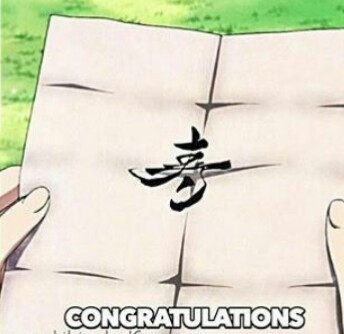
The kanji written in the note 「寿」 which is read as 「ことぶき」 or "kotobuki" simply means "congratulations" "best wishes" or "longevity". It is a formal kanji used for formal affairs (weddings, duh!) and definitely not for the birthday of a partner or love interest, in which case it is preferred to use some variant for 「誕生日おめでとう」 or "tanjôbi omedetô".
Also, no, the wedding didn't take place during Sakura´s birthday just because it looks like a "Hanami" event because there isn't a fixed date for such a celebration. The date on which it is celebrated depends on the region where it is celebrated, ranging from March to May in the northernmost parts of Japan.
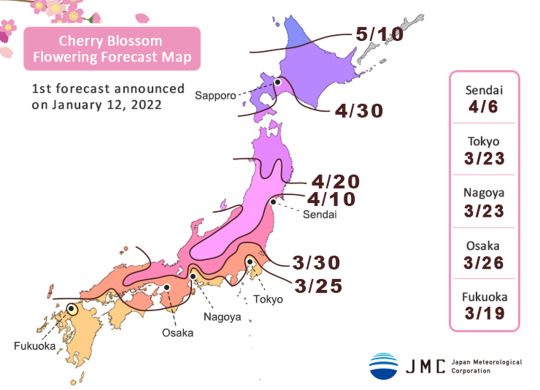
The summon landed on Sakura's arm because at that moment Naruto was indoors and Sakura only smiled and blushed because she gets off on anything Sasuke related and is creepy.
(pt.2) Sasuke's not so subtle fuck this wedding congratulatory note
I don't know who was involved in this wedding thing but I don't think this wasn't on purpose. I can't believe I have not seen any discussion about this, but well, I joined Tumblr relatively recently, and there must have been some mention around Japanese forums that I most likely won't have the time to look for. (let me know if you have more information)
Anyway, for context, there are many social conventions followed by the Japanese people depending on the circumstances. One of the many that apply to celebrations is 「祝儀袋」 read as 「しゅうぎぶくろ」 or "shûgibukuro" which literally means "envelope for monetary gifts". Now, this could apply to funerals, new year and, of course, weddings, and there are strict rules one must follow to avoid being rude.
The amount of money gifted depends on the closeness of the relationship between the new couple and the wedding guests.
The amount of money must match the envelope. In other words, if you are using an expensive fine envelope, you should gift more money and vice-versa.
Even when you won't attend the wedding you should send a "non-attendance" envelope with a fixed amount of money.
The details and ornaments on the envelope the guests choose reflect upon the wishes they have for the newlyweds.
Here I present some examples:
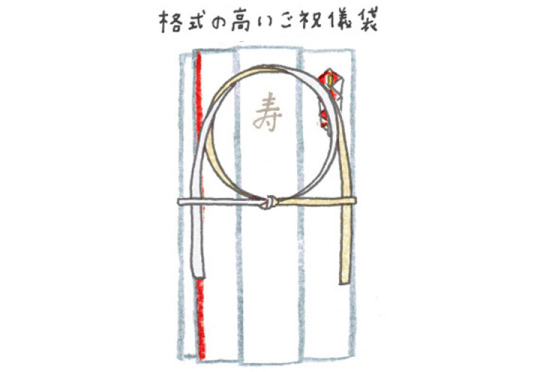

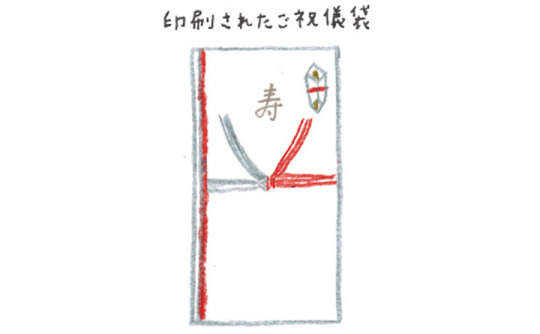
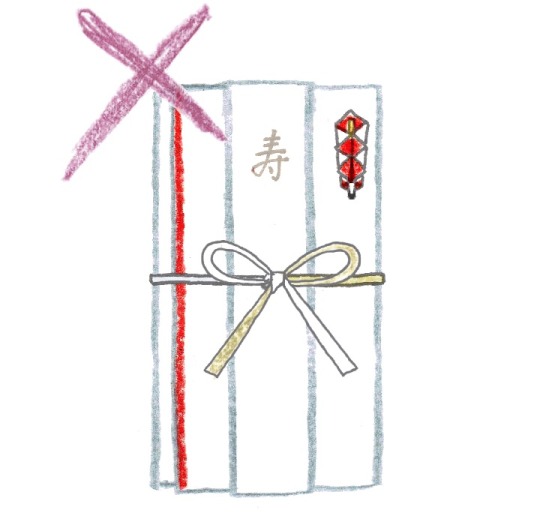
First of all, you can see the kanji used in all the envelopes is the same Sasuke used for his note. The ornament that looks like an origami figure means good luck and the more complex it looks, the finer is the envelope. The same goes for the complexity and color of the knots. A golden-silver cord is better than the red-white one and the more difficult a knot is to unravel the better, because it means the newlyweds have strong bonds. The knot in the first image is one of the bests because the shape is meant to represent a rising sun and the start of a new stage in the couples lives, also its the most difficult to untie. The second one is considered standard and the third one is for no-attendees. The fourth is not recommended because the knot is easy to untie.
There are many other characteristics, but I think this overview is enough to understand Sasuke's note was a direct pronouncement against the wedding. As Naruto's best friend he should have sent half of his Uchiha inheritance inside an envelope like this one

What did Naruto get?

A "Fuck you" would have been more subtle.
Edit: What Naruto got from other wedding guests
****************************************************************
I'll leave it here for today, but expect the analysis of Kakashi and Iruka's conversation. Iruka and Naruto as well as Naruto and Hinata looking at the Hokage monument.
If you are skeptical about the information I shared, here's my source and there are lots of youtube videos where this is also explained.
#sns#sasunaru#narusasu#sns analysis#anti naruto ending#anti sasusaku#anti naruhina#japanese culture#anti sakura haruno
270 notes
·
View notes
Text
I need to COMPLAIN.
This is gonna sound edgy nerdy not so girblogger coded but let me getto out of my silly girlie pop character for a minute i am RAGING.
For context two days ago i suddenly remembered that WEBTOON exists after trowhing it in a black hole in my mind, so i re download it and i start reading one. Apart from the endorphines i forgot a good webtoon gave me,
(whole other talk about redescovering old intrests !!!even if they look silly!!! when you feel a dry mind)
I finished it in a couple of days, and as i usually did when concluding a webtoon, a comic or any possible thing i liked, i start looking for the edits so i can imagine myself being in that universe while playing them.
(its a physical need i swear)
(No judgment let me being a cringy kid at the sound age of eighteen thanks)
(Its a guilty pleasure.)
Getting to the point. I am in DISAPPOINT.
What the fuck are these dry stupid no personality rage triggering edits.
They are MID.
Feel free to be' offended i stand where i stand
What the hell are these kids doing!?!
I had to scroll through YEARS to find the good ones.
So i started my reaserches.
First of all, i got to the sad conclusion that instagram edits are going through extinction.
Back in the days (☝🏻) when tik tok (musically for the ancient) wasn't that big of a thing for edits, you went on instagram (at least i did!!) And they were TOP TIER.
Masterpieces.
I would've hanged them on my walls if they were physical.
They were energetic, fresh, powerful, you could tell who's edits were by they're style because the editor's styles were so different one another.
They fitted the medias perfectly and don't let me start on the transitions.
They were immaculate.
Perfect to the millimeter.
These type of edits made me immerge in the media even more, i had my favourite edits saved, (a LOT), and i watched them every night before going to sleep multiple times, they were a lullaby to the mind.
But on my trip to these new (and few) Instagram edits... I was horrified.
First of all, no character whatsoever is put in these digital scums, the personal style is gone.
Probably due to these ages generations who wants to look the same be one another fit into something precise (I dont have the strength to start another fuss I'll just keep going with my silly polemic) but the transitions.
They are MID MID MID even terrible.
Actually I hate them.
There is not an ounce of effort in those disturbing sliding of images.
There isn't flow, variations,good blends. They all look like they were made by 10 year olds (wich is prob the case) and don't tell me oh it's just the age they'll learn as they grow.
No.
I want the twelve year old freaks that edited like it was they're last day on earth.
Like theyre life depended on it.
Where did they go?!?
What's wrong with this generation? why didn't they pick up the heredity theyre ancestors gave them?
Why did they throw it all away?
Why are they descending into this madness abyss?
And the music choices.
Disgusting
They never match the mood of the fiction, or worse the mood of the edit itself.
And honestly they're just boring ass songs.
Now, what I said about these Instagram edits applies also for the tik tok ones, but with some differences.
First of all, because there's much more editors on tik tok now, luckily there are some exceptions.
Some good stuff that's going on, but for me it's still not enough. From the parameter of the golden age of edits, those edits are just.. average.
The average good stuff you save and lightly watch. Its hard to find an edit that makes you obsessed. It wasn't really back than.
And most of them still lack the personal style, that again, I think its crucial for the ideal enjoyment.
I also noticed that the capability of the editors changes based on wich media the edits are of.
Like for example the editors of jujutsu kaisen (dont ask me anything i didn't see it) aren't doing a so bad job.
Maybe because the target audience is older so are the editors, idk
But it still lacks something.
That sparkle that was there before
The one that made you crave to watch it again and again
Maybe it's just me who's lacking something I had before , and nothing else changed
In conclusion, I think the editing culture ended at the start of 2022.
Idk tell me you opinion so I don't feel crazy thanks!
(Sorry in advance for the bad english i'm not a native speaker or anything)
(Edit not sorry this is a masterpiece I should be employed somewhere my English is near perfection)
#webtoon#webcomic#girlblog#girlblogging#edit#edits#webtoon edit#media#social media#society#nerd#comics#comic edit#webtoons#hooky#hooky webtoon#lalin's curse#ghost eyes#ghost eyes webcomic#homesick webtoon#homesick#school bus graveyard#old tumblr#old internet#nostalgia#polemic#mid#girlhood#girlblogger#chloe sevigny
16 notes
·
View notes
Text
Unfinished Business ~ Part 4

WORD COUNT: 4.5K
WARNINGS: Mentions of mafia, strong language, murder, blood
PAIRING: Bang Chan X Reader
DESCRIPTION: Part four of nine of my new Bang Chan series.
You’re taken hostage but one of Seoul’s leading mafia families Bang Chan but he doesn’t take you because he wants to fake a marriage or make you fall for him in 365 days no…He wants to use you for his own personal gain. To take over another family but when you try to escape things take a turn for the worst and you learn Chan isn’t one to be messed with.(Please I suck at describing stuff)
THEMES: Smut will be included in a later chapter so this is a fic for a mature audience, Chan x Fem!Reader, Self insert
MASTERLIST | PREVIOUS | NEXT

The next morning you were walked down to the breakfast table as though you were some kind of prisoner, Seungmin apologised when he had to take you but you kept your mouth shut not wanting to breathe a word to anyone after last night. You hadn't slept at all, you couldn't get the images out of your head. It was hard to move something like that from your mind, she was like family to you and just like that she was gone. Sitting at the table was Chan, he was reading through something you didn't care about so you sat down where the empty plate was and it was soon being plated with food by Felix who gave you a sympathetic look. They all knew what had happened inside of that room and yet did nothing to help you stop it.
"How's your ankle?" Chan asked not lifting his eyes from the paper he was reading from, searching for any news on Namjoon or about what had happened with Mrs Lu - there was nothing there. He wanted to move his eyes from the paper though, he wanted to look at you and see that you were okay. He knew you wouldn't speak much after what he'd put you through the night before. He knew that it was harsh but it was what had to be done, even after a lengthy conversation with Felix about it, it was what was needed.
"Fine." You mumbled taking the cup of tea that had been poured for you by Jeongin and sipping on it ignoring the burning sensation on your tongue as the liquid hit it,
"Eat something," He said firmly, finally glancing at you from across the table, he could already tell you hadn't slept. Your hair was thrown up in a messy ponytail, you were wearing sweats and a baggy shirt not to mention you had bags under your eyes, Felix said he'd heard you crying when it was his shift so that explained your eyes looking so bloodshot and your nose being red.
"Is the bedroom not to your standards? I can have a new bed brought in if you'd sleep better on it?" You hated that his voice was laced with concern for you and your wellbeing when he'd been nothing but mean from the moment you came to him - or rather were kidnapped by him.
"It's fine. Couldn't sleep. Nightmares." Your voice was monotone as you stared at the plate in front of you not wanting to eat anything that had been placed in front of you.
"I'm not hungry. Can I leave the table?" It felt as though you were talking to your parents when you were younger,
"Not until you eat something. You didn't have anything last night." You looked at the food and took the apple from the fruit bowl in the middle of the table, biting into it while staring at Chan smugly who just sniggered at you.
"I'll give you it." He put the paper down and leant on the table with his hands as he stood up from under the table, dressed in his usual suit and tie.
"Han said you wanted to go out and pick paint. We'll make a day trip of it." You swallowed the chunk of apple you'd been chewing on out of surprise and stared at him, this was some kind of test it just had to be.
"You said I wasn't allowed out-"
"Unless accompanied, unless you're still planning on running..." He buttoned his suit jacket up looking at you with a raised eyebrow, it was now that you realised one of them had a slit in it but it wasn't shaved, it was a faint scar.
"No! No, I won't. I said I'll stay." You meant it, you meant everything you'd said. You weren't going to try escaping if it meant more people would die because of you. It wasn't worth it.
"Good. Jisung will bring you up a dress to change into. I'm still having a wardrobe picked out to match you perfectly." You nodded and slowly got up from the table, too scared to make some kind of wrong move around him. Then you began walking with Seungmin past Chan when his hand reached out to touch your wrist, you flinched and he froze. He stared at you for a couple of seconds forgetting everything he was going to say to you when he saw the way you flinched at his touch,
"I-" He forgot everything he'd wanted to say when he stared into your eyes, he could see the fear that you held in them. Your eyes danced from his eyes to his wrist and he let go not wanting to upset you anymore than he already had.
"Make sure she has some ice for her ankle, and bandage it up." He said to Seungmin but his eyes never left yours, you could have sworn that he looked concerned for you and he was. He felt terrible for your ankle, the moment he'd grabbed your ankle he wanted to punch himself in the gut. He knew how painful it could be to be chained up like that and he felt awful for doing it to you the moment it happened.
"Thanks," You whispered to him, quickly leaving him there going towards the staircase with Seungmin who then left you at the bottom of the staircase with Jisung who also felt terrible for what had happened. Except he was the only one showing it clearly, he'd never liked the killing aspect of their life, he never liked this life he only stuck around because of Chan and the boys. He began taking you up the stairs making sure to walk slowly enough so you wouldn't damage the ankle more.
"There's a first aid kit in the bathroom, wait here," Jisung said as he left to go into the en-suite within your room, you stared at the door where you could see him reaching through the cupboards above the sink. You felt bad for running out on him the night before but you had to try and get out. He'd been the only one to show you any kind of kindness except for Felix and Jeongin.
"Why does he do that?" The question came out without context when Jisung came back into the room with some scissors and a bandage, he patted the bed and you followed his orders sitting down lifting your foot to sit on his knee.
"Do what?" He began wrapping up your ankle in a blue bandage to keep the pressure on it and you hissed as he applied more and more pressure each time he wrapped the bandage around, it wasn't awful like Chan's the night before. It felt nice to have it there.
"He acts like he cares when he clearly doesn't after what he did to me." Jisung sighed looking at you from the corner of his eye, he thought you would have been smart enough to see through Chan's clear facade but he was wrong about that.
"I told you. We don't like to kill-" He tried to defend him again but you weren't going to let him.
"And yet he did," He gave you the side-eye he wanted to tell you the truth about everything, about last night and how things weren't always what they seemed to be but he continued to bandage your ankle up in silence deciding he valued his life.
"I have no explanation for anything Chan does, all I have is an excuse that isn't mine to give out. Just know that somewhere deep inside his head he's doing it because he cares." That was all he could say to you without going too into detail about everything that went on inside Chan's head, the original plan for you was changing day to day depending on Chan's mood and it was giving Jisung and the boys whiplash. Your mind was being torn to shreds. Cares? He didn't even know you?
"He cares for me? He doesn't know me-"
"He knows enough, we all do." The folder. You looked at the floor and tried to remember what was inside the folder, everything. Every single detail about your life no matter how big or small was in that folder, your parents, your grandparents, all of your jobs from the ages of 11 and up. If someone read it they could say they'd known you since birth, passed off as you if they wanted to commit identity fraud.
"But why?" you asked. Jisung scoffed and helped you stand back up on your feet, you could finally put pressure on your ankle without it sending shooting pains throughout your leg.
"You're going to ask me to explain his complex brain?" You knew it was a long shot when you asked so you nodded at him and he pointed at another floral dress sitting on the hanger on your wardrobe door deciding he wasn't going to talk about it any more than he had. He could get into trouble for what he'd already told you.
"He doesn't like to be kept waiting." He said simply as you nodded in understanding and he left the room for you to get changed, standing just outside the door so he could walk you downstairs when you were finished.

Walking around the mall with Chan was weird - mostly because you were hand in hand with him but also because people were staring the whole time. The hand holding was his idea, he knew it was one way he could get all eyes on both of you and that was what he needed. Eyes were on you wherever you went, you thought it was just because of who Chan was but he told you it was because he hadn't been seen with a female companion in a while.
"They're staring at me?" You whispered as you walked past another couple who both stared at you blatantly obviously, both of them mumbling to the other about you as you walked, the woman's hand covering her mouth as she obviously said something to her partner. You looked at the dress feeling insecure but Chan stopped once he realised where your mind was going,
"They don't like seeing powerful men with a woman at his side. You look fine. The dress is perfect." Before you could argue with him he pointed at the paint shop you'd requested to go to and you walked inside head hanging low as you tried not to think about people looking at you. His hand never left yours and when the man behind the counter began talking to you his grip tightened,
"Can I get classical white, runaway blue, and a set of your acrylic paints and paintbrushes please?" You said to him, trying not to stare at him as he stared at your hand with Chans you wanted to beg for him to save you but images of the night before raised back into your head, along with images of your grandfather.
"I have to take this," Chan said as his phone started to ring loudly in his top pocket he moved away from you and out of the shop, Felix stood in the door to make sure no one else could go in or out of the shop without him knowing about it.
"Would you like to see the paint being mixed?" The man asked with wide eyes trying to think of a way that he could talk to you in private he'd seen this before with Chan's type,
"I'd love to." Your voice came out shaky and uneasy so you followed him over to the paint shaker and he started it up it was loud enough to cover up the conversation he was going to have with you,
"Do you need help? We can get you out...Just say the word and I'll sneak you out of the back-" A hand was placed on your shoulder before it moved and a voice spoke out,
"That won't be necessary will it, baby girl?" Your whole body was on edge as you heard him call you baby girl again, his arm wrapped around your waist and you felt sick for the man's safety.
"No. I'm fine thank you." Your monotone was back and the man stared between you and Chan and you gave him a knowing look not to press for anything, maybe that had been the real reason everyone had been staring. They were trying to break you away from Chan and get you safe. It was no secret who Chan was; him and the boys were practically famous for what they did. You took Chan over to some canvas' and his hand tightened on your waist as he grew angrier, his pulse racing as he thought about someone taking you away from him. His pulse was beating so much you could feel it on your hip where his arm was resting.
"I'll kill him-" This time your pulse raced,
"He was just worried about someone's safety. Don't hurt him. I'm staying. I'm here. I'll stay," You promised with him and linked your hands together once more to show him that it was the truth, his pulse slowed back down and his expression softened as he locked eyes with you.
"I'm not going anywhere," You matched his soft expression and he looked at you wondering why you were being so nice to the man when you didn't know him but then he remembered the file. You'd always been nice to everyone, volunteering at the nursing home, at the hospital and regularly working for charities. Which reminded him of something he had to do soon and he wanted to ask you too.
"I have something to ask of you." He walked you over to some more paints and you nodded, you'd do anything if it meant no one else would die because of you.
"I regularly attend a charity event and would you like to go with me?" Charity? He...donated to charity your blood boiled at the thought of him only doing it to make up for the shit he did.
"What is that? Your sick kind of way of making up for all of the terrible things you do to people?" The words slipped out before you could even think about them and he looked mortified as you said that to him, it wasn't true at all. It couldn't have been further from the truth, the charity was something he held close to him that he'd been doing long before he came into this lifestyle. You could tell by the look on his face that you'd hurt him and you felt bad for a second, fearing that if you stepped out of line something could happen you tried to justify yourself.
"S-Sorry. I didn't think-"
"It's a charity I hold close to my heart. You will attend the function with me." It wasn't a question this time it was a statement, you were going and you had no choice in the matter. You nodded at him knowing the repercussions if you didn't say yes and he went back to looking at the paint like everything was normal.

Chan was off again on business, the moment you were done inside of the shop he told you he had to leave and you were sent home alone with Jisung, Hyunjin and Jeongin who were watching you closely as you walked around your bedroom as if they had nothing better to do with their time.
"Do you have any plastic covers, Chan didn't get some earlier." Jisung and Hyunjin exchanged looks as if they were having some kind of psychic conversation together.
"There's some in the office," Jeongin said nodding for you to follow him into the office across the hall so you did, walking behind him as he got into the room. You stood in the door and images came flooding back from what had happened the night before, the carpet was gone and replaced with laminate flooring as if nothing had happened. Jeongin followed your gaze as he realised what he'd done and where he'd brought you.
"Shit. Sorry, I forgot-" He was so used to this life he'd forgotten how it affected those who weren't used to this,
"It's fine," You lied looking down at your hands instead of the flooring. He began looking through drawers when you saw a bookshelf, sitting there in the centre shelf was a photograph of Chan and another woman.
"Who's this?" You asked, opening the glass doors to take a closer look at the image that was sitting there. Jeongin glanced up at you, panic rushing through him as you touched the photo. Chan hated it when people touched his stuff.
"Chan's wife. Shes- Shes not with us anymore." You ran your fingers over the photograph, she looked like you. She looked a lot like you, from the hair right down to the dress you were wearing. So that was what he was doing? He saw his wife in you and was trying to replace her with you? You put the photograph back down and Jeongin held up the covers he'd gotten from the bottom drawer. Maybe his ex-wife was the way out for you, maybe her being his weakness was your way out. Make him fall for you, make him weak and escape when he doesn’t see it coming?
"What are you painting?" He questioned as you walked out of the office. He locked the door and added the key into his pocket. Everyone had a key to the office by the looks of it.
"Sunflowers." You whispered as he walked you into the room, Jisung was alone now as he looked at the wall you were planning on painting on.
"Hyunjin is cooking us something to eat, Jeongin go and help him." The small boy left the room after dropping the covers onto your bed for you to sort out. You looked at Jisung from the corner of your eye as you poured paint out into the containers.
"You're being awfully calm for someone who'd spent the day with someone she hates," You ignored his comment, not wanting to raise any suspicion and took the roller dipping it into the sky blue paint.
"He was kinder...didn't hurt that man." He hummed at you, not believing it for even a second and stared as you starting to add a light blue to the wall.
"You didn't try to escape, that was the only reason he didn't do anything. Don't think he's going soft on you." You hummed this time, not believing him and he shook his head at you. All that filled your head was the photo of his wife and Chan together. His arms wrapped around her waist as he had a huge smile on his face, so big you could see dimples on the sides of his cheeks.
"How did he lose his wife?" You asked without moving your eyes from the wall it was an innocent enough question but you didn't want it to seem as though you were prying him for information because you weren't.
"Why?" You shook your head and looked over at him,
"I saw the photo. She looked young." He looked down at the floor. They weren't supposed to talk about her. They were supposed to keep their mouths shut. You weren’t even supposed to know that he’d had a wife so Jeongin had fucked up by letting you see the photograph.
"Is she the reason you're not allowed to listen to music?" He knew you were up to something the minute you asked that question and he cut everything short not having time for the bullshit.
"Whatever you're planning, get it out of your head now. Unless you want a repeat of Mrs Lu with your grandfather." You stared at him as he brought your grandfather up into the conversation,
"Do you think I'd plan anything after what I saw last night! She was like a mother to me and he ripped her away. I wouldn't disobey him again." It was only partially true, you were planning to get away but you were planning on making it easier on everyone else first.

Chan walked up the staircase to see Minho was asleep outside of your room, his head resting on a wall. He didn't blame him, it had been a long day at the offices. They were all tired and he was about to head to his own bed when he heard soft humming coming from your room, he was surprised you were still awake after not sleeping the night before. He pushed the door open silently to see you standing there with a paintbrush in your hand, you were sitting crossed-legged on a set of chest drawers sitting so close to the wall your nose could have some paint on it. He knew the tune you were humming but he couldn't place what it was, he watched as you added another brush stroke to the wall. He made his way inside until he was standing right behind you, you hadn't heard him thanks to your humming which had slowly turned into softly sung lyrics.
"Your favourite?" You fell backwards, your legs spralling out in front of you to try and catch yourself but Chan caught you quickly before you could hurt yourself. Your arms resting on his as you stared up at him and you realised you'd painted a bright yellow stripe down his suit jacket.
"Sorry, it'll come right out if you wash it right now." You struggled out of his arms and stripped off his jacket rushing into the en-suite where you panicked trying to wash the paint off his jacket. His hands rested on your arms to stop you moving so fast and for a split second, it felt nice to have him this close to you, a spark rushing up and down your body making you feel a little uneasy.
"It's fine. I can have it dry cleaned." He slipped it out from under the water and hung it over the shower since it was wet.
"You're scared of me?" You nodded at him and he tried not to sigh, it wasn't what he wanted at all he didn't want you to fear him this badly.
"They are." He frowned confused as you answered something else,
"My favourite, you asked. They are." You said pointing over at the sunflowers on the wall.
"You should be asleep, you haven't slept for almost 48 hours." You looked at the watch on his wrist to see that it was almost 3 am,
"I can't sleep....always struggled." You admitted to him and he nodded in understanding. He'd also struggled with his sleep for a long time which meant he had tips to help you.
"I struggle with sleep too." You ignored the need to make a quip about what he did for a living was probably keeping him up at night and he walked you over to the giant double bed pulling back the sheets for you.
"But you should sleep, we have an event later in the week and I need you to be well-rested for it." You got under the covers and stared at him as he tucked you into the bed and started humming to the song you'd been singing. So music wasn't something he hated completely. That was something that you could work with.
"Can I have a radio tomorrow? To work with while I paint?" He stared at you.
"I don't like music." He answered plainly not looking away from your eyes,
"Oh...Okay." He could tell how disappointed you were and he looked down at you. He hated seeing you look so disappointed about something, he never wanted to see that look again even if it meant doing something he didn't like.
"I'll see what I can do." He brushed the hair from your face and kissed your forehead. Softly sparks shot through your body and you stared at him trying not to give signs away that you felt them. You couldn't fall for him, not after what he did and who he was, he'd killed Mrs Lu, he ran drug cartels, money laundering, cold-blooded murder, gang wars and...Well, there were many rumours...Not everything had to be true did it? You wanted to question him on that now, find out what exactly was and wasn't true with him and his crew. Trying to get your head back into your plan, instead of what Chan did for a living, you questioned him on the music subject,
"Why don't you like music?" You shifted over in the bed so he could sit beside you, he stared at the space and you stared into his eyes.
"Tell me." You pleaded, placing your hand on his as he sat down on the space you'd left for him. He felt his heart warm up as you talked to him calmly and touched him because you wanted to, not because he was forcing you to.
"It's nothing, just something that used to be played a lot in the house and then there was no need for it." He took his hand away from you not wanting to get into this, it was too much for one night, he'd already told you too much. You were just supposed to be bait for Namjoon but he was starting to feel more for you, he got off the bed quickly and left the room slamming the door so hard that Minho jumped awake and stared at his boss rubbing the sleep from his eyes.
"Something wrong?"
"She likes music."
"That would be nice...right?" Minho and Felix had really been the only ones to calm Chan down when he got bad like this when he got upset over his wife. They'd been there for him the longest and it was them he could trust the most. Chan hummed in answer of Minho’s question and walked into his bedroom, shutting and locking the door behind him. He walked over to the photo frames that lined his desk, all him and his wife together in the earlier days of the marriage.
"Every day I miss you a little more." But there was something else taking over his heart, he stared at the photos and he no longer felt hurt by them. It was more of a feeling of peace as he stared at his once happy wife, but he was starting to picture his life with you instead of with her. He took the frames and placed them into the bottom drawer of a desk inside his bedroom and began changing out of his suit. He hated that he snapped at you like that, but he didn't want you knowing his weaknesses, you'd use them against him just like everyone else did. Just like Namjoon did with her...but then again. The plan had been to lure Namjoon out of the shadows with you, use you as bait to get the confession from Namjoon but now he could use it to his advantage. Namjoon could scare you into staying with him and Chan wouldn't have to be the bad guy anymore...He could be the one trying to protect you instead he just had to come up with a way to get it to work.

Tagline: @moonprincessdiviniation - my beautiful and wonderful editor, @jooniesdarlingdimples @taestannie @kneel-begyourpardon @calling-dips-on-j-hope @hugs4chan @ncitythoughts @inseonqt @cloudsgathering
#skz#skz x reader#skz x you#skz x y/n#skz imagine#skz imagines#skz smut#stray kids#stray kids x reader#stray kids x you#stray kids x y/n#stray kids imagine#stray kids imagines#stray kids smut#bang chan#bang chan smut#bang chan x reader#bang chan imagine#bang chan imagines#seo changbin#changbin#lee minho#minho#hwang hyunjin#hyunjin#han jisung#jisung#lee felix#felix#kim seungmin
411 notes
·
View notes
Text
time to rant about how i think the dance in emma (2020) is way more effective than in p&p (2005)
let me explain (buckle up this is long)
“they feel like they’re the only ones in the room/they only see each other”
p&p (2005) tells it to you right away and then shows it to you
emma (2020) there’s a whole fucking journey to get to it
in p&p, it starts with this:
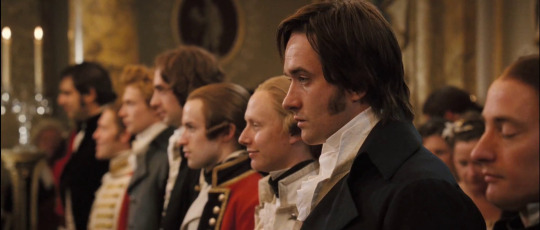
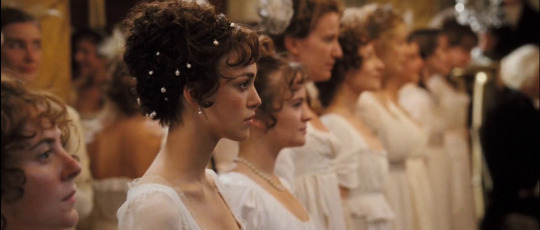
there’s a boy, there’s a girl
the camera follows them one at the time until they meet in the middle during the dance

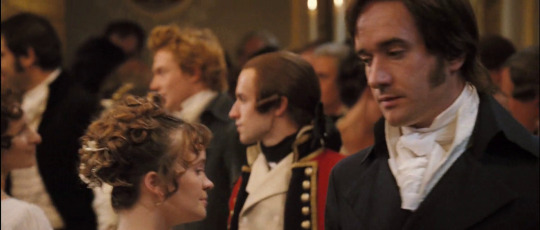
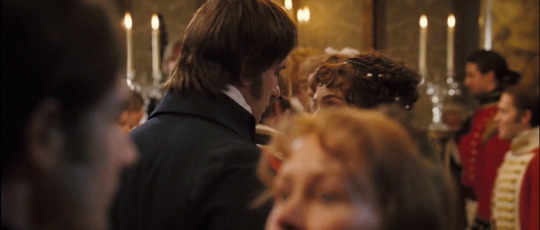
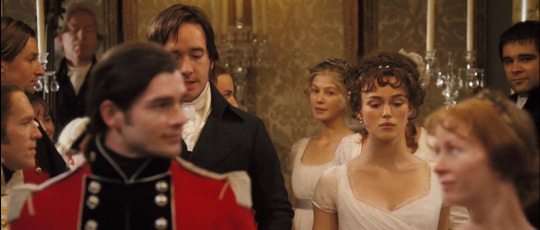
the conversation heats up, they stop stopped dancing. effective.
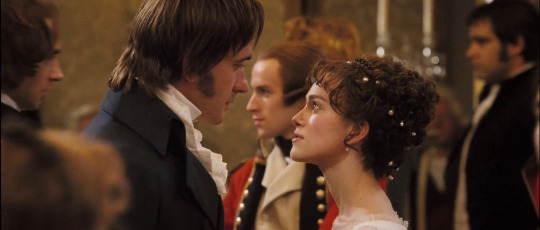
then, they start dancing again
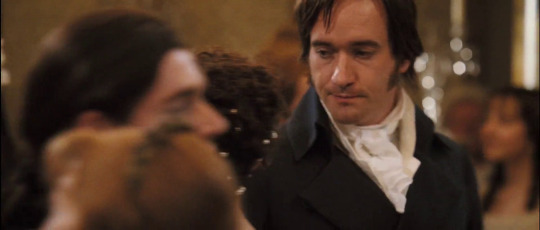
it’s the last shot you see before it cuts to this:
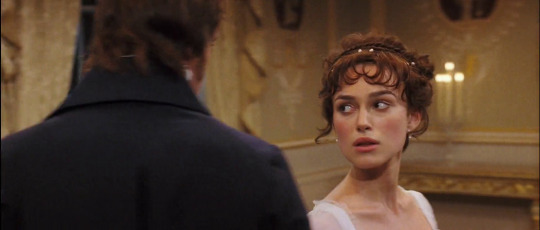
then they’re dancing alone in a room bla bla bla until it ends we all know how this goes
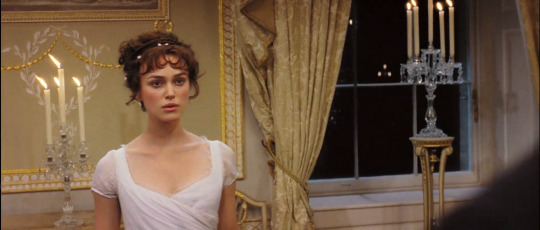
and then it cuts to this

the fucking cuts: - it inexplicably cuts to other shots that are not continuous with the last shot you just saw. why. i have no clue. it doesn’t really add anything. you’d think it’s like a quick reminder that oh they’re not alone in the room, but having watched it again, i don’t get that vibe. i just get “they’re alone, now they’re not” and there’s no explanation for it other than you know they’re gonna hook up and this was meant to be a moment. there’s no loud noise that brings them back that could explain this kind of cut, there’s nothing. - i would have wanted a smoother transition. maybe digitally remove people one by one, or use one of those secret cuts for one shots when people block the camera by walking in front of it to then, again, smoothly see that oh people were here but now they’re not but you’ve been here the whole time you didn’t have to fuck off somewhere in another room to be alone. it happened all organically. - really fucking irritated about it. i really like SEEING them alone in a room, but it feels a bit patronizing in a way, as if they weren’t able to convey it or were too lazy to show this feeling in other ways
it’s kind of ordinary? - having seen emma, i can’t find anything spectacular about the way this was filmed. it’s just the camera playing ping pong from the same spot, then the camera circles them. i love the flow this has because you get the horizontal match of ping pong at the start (as it reflects their discussion -- very nice) and then, once they’re alone, it starts flowing and moving more freely. fucking wonderful. but you could also do that with any other scene and it would lose this meaning because there’s nothing else that makes it special. - and because of that, it doesn’t seem to be much visual storytelling happening, and by that i mean if you were to only look at the screenshots or watch it without audio, it doesn’t give you much to go on. two people dance and seem to talk, they stop, they look angry at each other, then they’re alone in a room dancing again. the dialogue and the music basically provides most of the storytelling in this scene, which, you know, it’s perfectly fine, but you’d think a scene that has this much impact would have a bit more? - all you get are three images from the same pov: her alone, him alone, them together. do i want more? no, it’s perfect the way it is. HoweverTM:
they actually visually tell you they’re alone before they show you they feel like they’re alone in the room - the filming already preps you for the big moment. they only focus on them. that’s it. that’s the whole scene pre-alone scene. they focus so hard on the characters that you already know they feel like they’re alone; they’re having a heated conversation in public during the middle of a dance. they already feel like they’re alone. otherwise, what’s the purpose of it all? if i can assume this from the context and how it was shot, why do i need another reminder? why both? why not just one of them?
dumb complaint, but the opening shot... - it gives you zero context. a good thing about it is that they show mr darcy first as to say hey this doesn’t happen often, this is special, buckle up. but then again, it starts with a somewhat close up and they never go in or out until they’re in the room on their own. there’s no perspective to it. i’ll call myself out and say it’s a really stupid thing to be upset about because, for example, if i wanted to show someone feeling lonely, you could fill a frame with their face and show there’s nothing else but them, EXCEPT the most effective way to show this would be a wide shot where they are indeed alone or in a corner. both are GREAT it depends on the context of the scene, of course, but my point is, why not just take the opportunity you have. you can open with one wide shot and never come back to it. at least you’re acknowledging this isn’t just about them. (it IS just about them, but since we already KNOW this by looking at the scene before it cuts, them being alone doesn’t have as much of an impact as it could)
it’s stupid how much i used to LOVE this scene and now i can’t even find anything to ramble on. it’s the same two things. it’s not like i have much to talk about.
so now there’s emma who just fucking went for it and annihilated p&p’s dance
there’s a context shot. this is it. you’re not meant to spot them, you’re meant to know they’re going to dance with lots of people surrounded by lots of people. this is important for later on.

now you get introduced to two important angles (hell yeah)
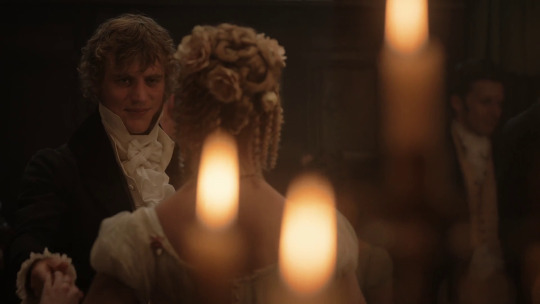
this voyeuristic candle pov that makes me want to fucking nut. this is my favourite pov. it’s meant to be her point of view, but as you’ll see in later shots from this angle, the meaning also doubles as OUR pov, like we’re intruding and watching from afar. i think this is very efficient because you get variety, personal interpretation, and depth. depth as in you’re behind the candles and they’re in front, you ask? no! the most important aspect is the horizon line!! they become the horizon line, and the people we barely make out in the back become just shadows in the background, and therefore, unimportant. you don’t need to make them leave the room to make it seem like they’re alone.
and then there’s this one, his point of view, but still not an over the shoulder look, so it’s still as if we’re looking from the side, but we’re not intruding as much, because this just sets the tone, they haven’t even begun dancing. there’s no need for two of these candle shots. the horizon line & background people thing still applies to this, but in a less dramatic and obvious way.

then we cut to this:


the smartest thing about this is that
1. you’re still intruding
2. the camera faces the side of the room with the most people (take note of the band)
3. in the second shot, it feels very intimate even though they’re surrounded by people so much so they block us from fully seeing them
then we get the first part which is only filmed this way once. (again, as an introduction to give you context.)
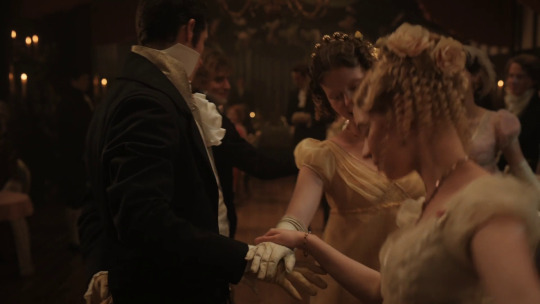


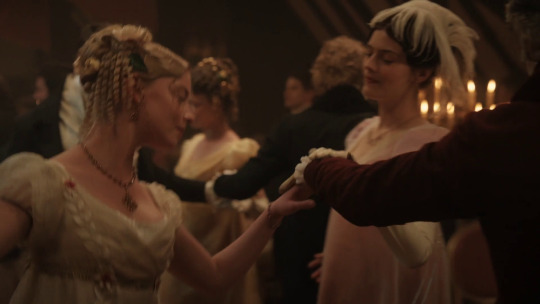
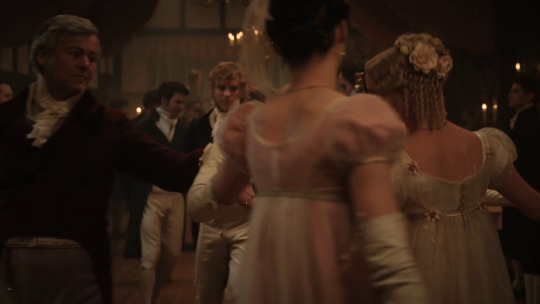



there’s a few important things here
the movement because they don’t insist on focusing on them at first to give you the vibe in the room, you get a lot of people moving in front and behind the two we’re kind of supposed to be focusing on. i think this is brilliant. it makes you want them to be alone, but they’re not there yet. you have to wait for them.
the lookTM even though the camera moves often and the shots change, we see him looking in her direction whenever he can. it’s so SIMPLE and it adds to two aspects: 1. the whole voyeurism thing; you’re catching him do this, it’s not meant to be a focus point 2. they’re slowly starting to show signs that they’ll feel like they’re alone in the room. the whole “staring at someone and being so enthralled by them it feels like it’s just the two of you”
now we get a subtle change. the camera switches sides and faces the other way. there were five visible musicians and we don’t see them anymore. remember when i said i would have liked for p&p to slowly remove people from the room? THIS is how you can do it, and all that was done was filming from the other side of the room. not only that, but there are only two couples next to them from this angle, unlike the other where there were three or four i can’t remember.
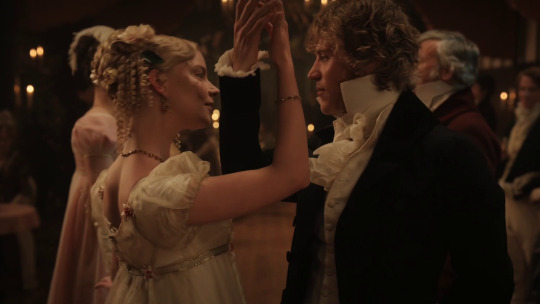
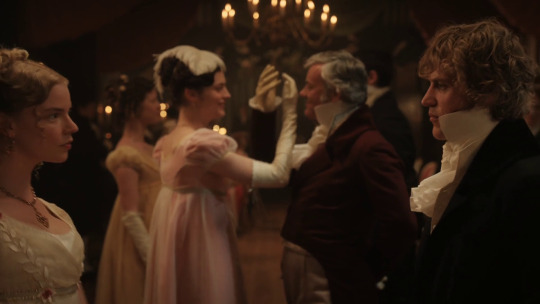

this is a nice way of controlling the crowd. are there more people in the background? we don’t know because we get a couple hiding them from us, keeping yet again a low people count, and then we get our two idiots literally blocking everyone from us and them

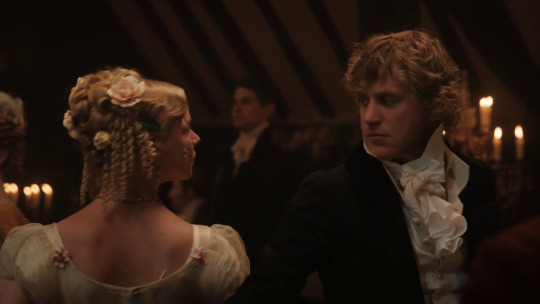


this has the exact same intensity as when darcy and lizzie are dancing in that empty room and yet. you get the effect of an empty room without having to vacant the whole place down.
this is also when it starts to get real romantic up in here. up until the twirling, there were a significant amount of people in the shots, but now, you’ll start seeing less and less (with one exception) of them. doing it gradually builds up great tension and makes you feel like you’re part of it.



it takes up until now to have our first close ups. the neat thing about it is they’re doing the same moves that first introduced the concept of them blocking out people in the room. filming like this (from the outside in) also induces the feeling of blocking out people
then we get a surprise midsection shot:
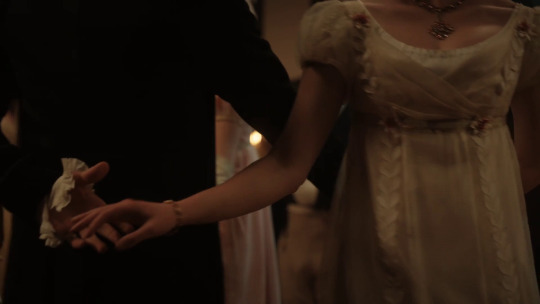
i thought about this a lot because it has the same vibe as the cut in p&p, but the thing is,
all the previous shots were from head to waist and the face close ups. there were NO close ups NO focus on anything specific. it’s kind of the visualization of “what happens under the covers” and i don’t know about you but......
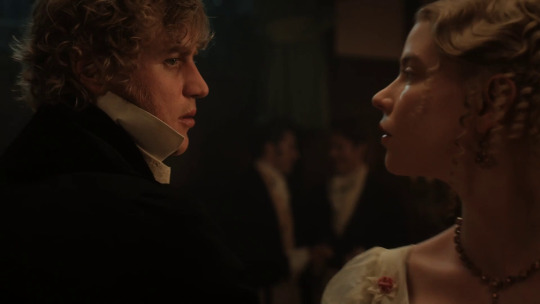
bedroom eyes much??
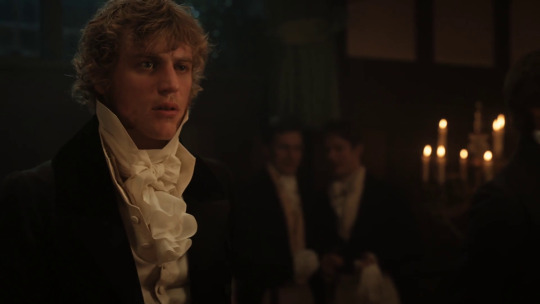
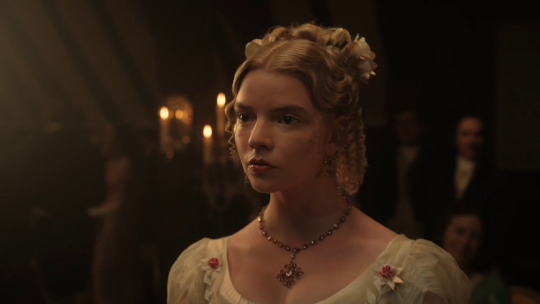
they still are in the room, people are STILL dancing, we still SEE them in the background, but the camera focuses on the two. they’re simple shots in theory, but along with the whole journey you’ve just been through, it means so much more. these close ups are more important than they should be. the more they dance the closer they get, the more isolated they feel.
now there’s this part which i ADORE. she advances to him, but in a way, since it’s not a typical over the shoulder view, it feels like she’s coming toward us too. it’s done so slowly too, almost hesitantly, and the next shot of her back preps you for the next big moment.
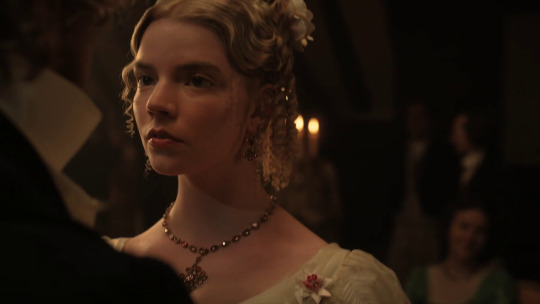

before it happens though, there’s a quick throwback to the fact that there’s still people. autumn de wilde really said i got you bitch they’re not alone. it’s a weird thing, i’ll tell you, but i kind of adore it. it’s like getting cold water thrown in your face because we forgot.
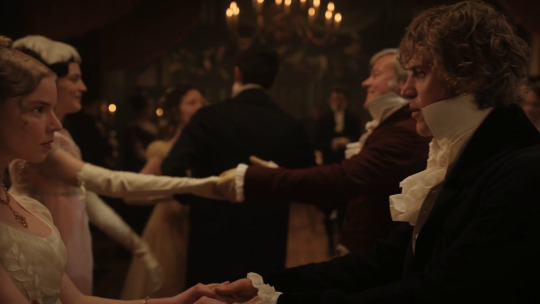


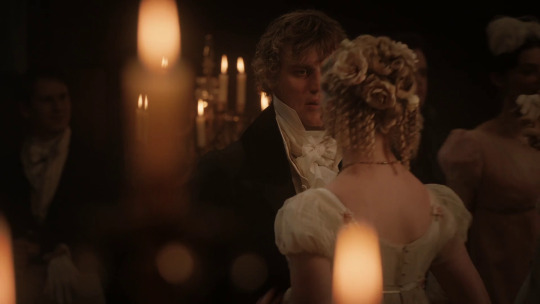
i would have gifed this part but i’m lazy. their dancing come to a stop. just like how it did in p&p (before it CUT) and emma just yeets away from him in that last shot to continue dancing, like she too forgot herself like what just happened to us with that cold water shot. (the next shots prove he too has been splashed in the face and it’s not a one sided thing, or something WE looked too much into)

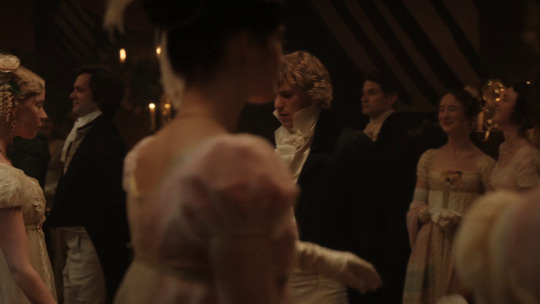

having yeeted away to take their place to dance again, the camera pans over to them. it follows them. like they were trying to escape all this and what just happened was clearly private.

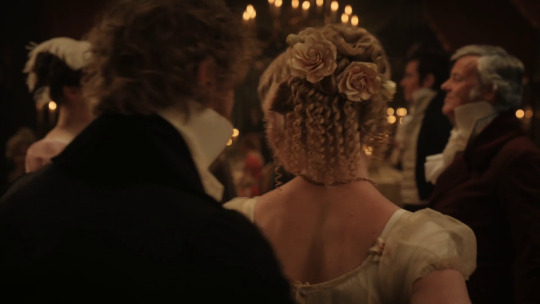
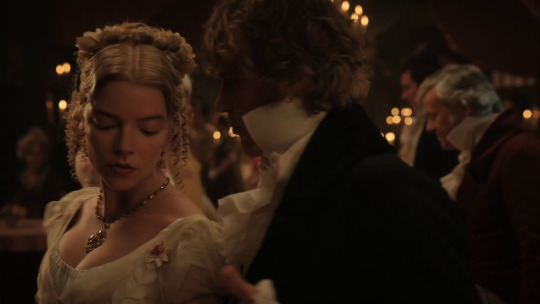


and then the shots become more like they were at the start. wider. there’s people in frame again. but then they twirl to stop in front of the camera, blocking them again. they know.
and then you see why they stopped. if you look closely in the background, they danced on their own. this isn’t part of it. nobody’s dancing, they’re still in position, waiting. these two just went off on their own.
because they feel like they’re the only ones there.

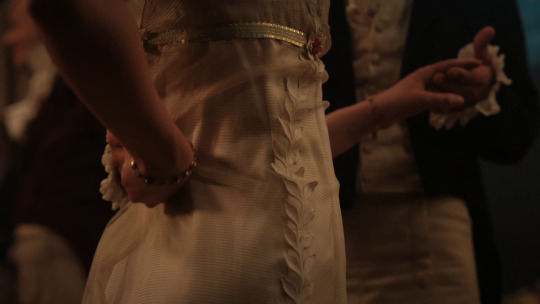
it cuts to her dress again, them holding hands again. we’ve been prepped for this, but this time, knowing they weren’t MEANT to do this, it feels much worse.


and they retract, because that’s that. what more can you do.

and then it ends here. it’s too late, and you don’t need another reminder they weren’t alone.
it doesn’t matter anymore.
515 notes
·
View notes
Note
Hey so I wanna start writing botw fanfiction of my own, and I was curious if you had any tips for writing for this fandom?
I don’t know what gave you the impression that I am qualified to give advice, but I will try!
If you have the game, I find it helpful to actually go to the places in Hyrule that you’re writing about, so you can get a sense of what everything looks and sounds like, and even gather context clues of what it smells and feels like. Plus, to make sure the tone of my whole fic is consistent, I usually put up music from the BOTW OST or whatever music fits. Then I couple it with the website A Soft Murmur for any other world building sounds, like fire, wind, rain, birds, or whatever
You can use the website Guide of the Wild to find any other details whether on the map or compendium if you don’t have the game. And just searching up images or gameplay works too
Take advantage of the great world of botw to pace your dialogue! My biggest struggle (and pet peeve that I can fall into myself) is dialogue pacing. Sometimes it’s appropriate to write blocks of text for context or exposition purposes, but for regular banter I always like to put a few sentences in between to flesh out the actions and scenery. This person says that, as the wind blows their hair into their face. That person responds, while running their fingers on the morning dew caught on the blades of grass. Stuff like that
Sometimes I’m tired of switching between the character’s name and “he/she/they” so to spice it up, I use “The Zora” or “The Hylian” (etc. etc.) as an alternative. Although, this only works if you’re working with two different races, and it ultimately depends on how your fic flows
Do the characters that you’re most familiar with or you feel you understand the most. Don’t feel obligated to shove Zelda in just because they hang out with Link, if you don’t know how you’ll use her. Unsure of how to write for Sidon? Then don’t! I promise you that a fic is 102% better when you write two characters really well, rather than shoving in a few popular ones for the heck of it. It’s you world, do what you want.
More under the cut:
Then again, if there’s no way around it and you need to write for a character and you don’t know, first I’d rewatch all cutscenes with them on youtube. If that doesn’t give you ideas, try the Creating a Champion book (There is a free pdf online, and it’s also great for references and research/world building in general) and if you can’t get anything from that, just search up headcanons and fics about that character from other good works. Luckly, most of Nintendo characters are crafted around a simplistic trait, and are made more complex off of that starting point. Sidon is kind supportive shark prince, Revali is an asshole with a heart of gold, etc, etc, so just build off of whatever character traits you have.
And again, you’re the one writing the fic, so honestly you could write them however you want. Write for yourself first, rather than writing to appeal to canon
Dialogue has so much room for characterization and take advantage of it, especially for Nintendo characters because again, they’re usually written around a central character trait. Revali uses long, complex words to show off, Mipha is typically more soft spoken and polite. So did your character “say” something? Or did they “enunciate their words,” or maybe they “whispered tentatively while avoiding their gaze.” Did they say “That’s great,” or did they say “Extraordinary! Fantastic! Truly this is a marvelous event!” Or maybe they said “Who would have thought? I certainly didn’t expect something so monumental coming from you.”
I don’t even have to say the characters but you know instinctively what kind of characters were speaking for those last two, just from the connotation and diction alone. Use that! Use your word choice to convey character!!
Now this might just be the screenwriter in me speaking, but I usually frame my scenes using the upside-down triangle method. LFTS explains it really well in this video, and you should just follow them in general. (Also the youtube channel hello future me has some fantastic videos on writing so follow them too!)
Anyhow, the upside-down triangle or funnel method is basically the principal that the first line of a scene establishes the broad premise that the scene moves around, and the last line of the scene establishes the point and purpose. (Now this doesn’t really work that well for one-shots on cute fluff or whatever, and it’s more of your multi-scene things, but there are a few things you can still apply!)
It doesn’t have to be your literal first line or last line, but essentially it breaks down into a question and an answer. The first part of a scene should establish a question, and the stakes. Why are your character’s here? What do they hope to gain? What is preventing them from such? What is there to lose? Then the scene ends with the funneling point, purpose, or answer. At the end of the scene, they realize their feelings despite the obstacles, or they decide they have to go rescue someone, or maybe nothing about their attitude changes at all, despite of something.
See using this method I’m able to focus on the purpose of a scene, I can frame my dialogue and banter to establish characterization and motives easily. I can make sure that every detail and action serves to further the scene’s ultimate goal. I can pace everything to my liking, to make things more dramatic, tense, or comforting, and I can cut out anything that isn’t needed
When you follow this, it makes the payoff, the resolution, or the tragedy all the more satisfying. This kiss is all the better when it’s framed as the perfect funnel point after a scene centered around the premise of their pining, or banter. The angst hurts all the more when your entire scene is focused on building tension and growing insults that dance around the question of “why?” Scenes should either move towards, or away from a certain goal or point. If nothing changes, if it affects nothing, and it doesn’t add to world or character building, scrap it.
Also write your scenes out of order if you must! You have all those great ideas for dialogue and cute fluff or whatever, but you’re not at that point yet? Write it down!! You will forget, and you will regret it. Write the entire ending if you must, even if you haven’t finished the first scene. In fact, you should actually do that because again, the funnel/upside-down triangle method means that the ending is a very important part. So yeah, when you get that idea just write it in the margins, don’t stop the flow of your brain!
I act out my scenes. It’s stupid but it works for me. I say the words outloud as I talk down to the dishwasher. This way I can also get a sense of the body language, whether it be for Revali, speaking to someone with his wings tucked behind his back, or Sidon who always expresses his gratitude with grandeur arm motions!
And I keep using Revali and Sidon as examples because foils!!! Botw characters are so perfect for foils oh my gosh. Foil your characters, please. If you’re using a side character it’s so great if they are also a foil. I already mention Revali and Sidon being opposites, but similar things can be done with Yunobo and Link, or Zelda and Mipha. Foils don’t mean that an entire character is the opposite of another, just a certain trait. Teba and Revali are similar in their attitudes, but still work as foils when talking about Revali’s flamboyancy to Teba’s stoic and grim demeanor.
Final point, if you didn’t enjoy writing it, if you wrote to please someone other than yourself, you did it wrong.
43 notes
·
View notes
Text
Blackboard Prompts
One lump post - might be in other parts of the daybook, but should all be here:
#1:
I have answered this in other entries, but the image that I had of London was one of a fantasy. London is a place where supernatural things happen. It is the setting for books and films. It must be a fantastical place, near mythical. That rather contrasted with the things people would tell me about the weather and the food in London, but I found things like the London fog charming. It gave me a visual of a city draped in a perpetual shroud of mystery. That being said, I knew virtually nothing about London beyond what I know of any big city. I have traveled quite a bit, and big cities often share some things in common, such as public transit, noise, and crowds.
I’m not expecting much of the food or the people, to be honest, but that is because I have a lot of respect for hospitality customs in America. People are often friendly and open to conversation. The food quality is dependent on the place, but usually, big cities have better food options and more diversity. This is not my first trip to Europe, so I have some idea of what to expect. I have not, however, ever been to London, so I might be surprised. I have doubts, though. I fully expect it to be as beautiful as I’ve always imagined, but my faith in people and food is not as rose-tinted. At last, though, I will be able to say that I have been to London, and I cannot wait.
#2:
My experience flying to London was odd, yet typical—an interesting contradiction, which is amusing to me in recollection. I arrived far earlier than I need to at the Pitt County airport, and I felt bad for several reasons. It was nice to meet everyone again, but I can never sleep before a big trip, especially before a plane ride. This is deliberate. I need to be able to sleep on a plane, or the discomfort drives me insane (as do the pressure changes). Usually, I try to sleep for the majority of any plane ride, from boarding through landing. However, TVs were invented, and not only that, everyone gets one on a plane. To commemorate the occasion, I admit that I watched a good deal of British-based TV/film on the way to London. It was a long enough plane ride that I had time to watch TV and catch up on sleep. It was probably one of my more comfortable long plane rides, so I have no real complaints.
As for the first day in London, the first day is always hard to acclimate to. I try to adjust to the new time zone as soon as possible whenever I go anywhere. The first day is always difficult (yes, it bears repeating). People are tired, hot, hungry, overburdened, lost, and overwhelmed in general. I did like getting out to see some of London that first day, however. I want to learn the transportation system as quickly as possible, but I’m not worried. The London Tube is much easier to navigate, from what I’m seeing, than the Metro in Italy (or most other cities). It’s quite time-consuming, I’ve noted. I try to factor in travel time when I’m planning excursions, and this might cut into my plans somewhat. We’ll see how things go.
#3:
I have to say, my initial perception of London has not really changed, even over this past week. Maybe I am jaded from an excess of travel experiences, but I have not really been shocked by anything. I wasn’t even surprised about the scaffolding mummy that is currently Big Ben, the clock tower, and part of Parliament. The same has happened anytime I have gone anywhere; it becomes a familiar frustration and feeling of resignation after a time. You cannot change your timing to such a large degree, so maybe if I ever get the chance to come back to London, something else will be in the midst of restoration.
I have been a bit disappointed by British tea, I will admit. I can be a bit of a tea snob, but I grew up with strong Chinese teas. I entertained the myth that British tea is without peer, but mainly, it seems to be unmatched in expense. At least the pastries are good, and I got a huge kick out of trying London cuisine that I have read about in books, such as meat pies and British biscuits. I think the thing about London that is superb is the architecture, the buildings and structures of old. I would never want to live in a castle—too many steps, and that’s not a mindset that will ever change for me—but I love to tour through them. Seeing a castle in the middle of a modern city never fails to make me feel like I’m standing in a fantasy land. It’s so much fun, and there is history, and more, in every stone. I want to see as many castles, museums, and art as I can.
#4:
I once got into a discussion about “natural” vs. “supernatural” vs. “hyper-natural,” and I loved that topic because the words themselves have certain connotations, and nothing is easy. For me, I make the distinction between natural and supernatural as reality versus fantasy. I try to be honest with myself and to keep separate libraries about the real world and the fantastical narratives. Nature is natural. A magnificent waterfall pouring over a cliff. A bird building a nest. These things usually happen without human contrivance. When not reading fantasy books, I often think of human designs as unnatural. We often appreciate those human constructions just as much. Things like Stonehenge and the Great Wall are precious to us because they are not naturally occurring spaces.
I looked at the London Eye, and it is incredible, but it is the unnatural mimicking something natural. If we want a “bird’s eye view” of London, well, we can’t fly, but humans can build things that will accomplish supernatural goals. We create folklore legends to explain things that defy explanation. Supernatural is something not natural but more than human. I love discussing supernatural tales, learning about where they came from and why they came about. Science often takes away some of the mystery, which can be riveting in and of itself but boring if you like narratives.
#5:
I miss air conditioning. I knew to expect it, but AC might be the sole reason I never want to live anywhere other than the U.S. That lack never gets easier to bear (unless it’s not summer). If I were to create a monster in a novel, it would be wreathed in flames and too hot to bear to be around. It would also probably be from a swamp—with roots from living in a floodplains area, but such is inspiration. I don’t think I would feel bad about acknowledging these things, either.
As for things that have gotten easier, getting to and from the Tube, and the buses, has gotten easier. It is such a common mode of transportation here that it is beginning to feel natural. I’ve only used one taxi, and that was near day two. I miss my car, though. The Underground is terribly loud, stuffy, and generally uncomfortable. I have come to associate travel with discomfort, which makes me think of Richard and Door. They can’t fly like Peter Pan. Even though Door can open doors, they often have to get around the mundane way. It’s nice to come home to creature comforts after a long time away.
#6:
The “monsters” in the novels came as no surprise to me, particularly with A Monster Calls. Ursula le Guinn and Lloyd Alexander, to name a couple, did something very similar in their writing, although I must admit that Ness’s monster was far more three-dimensional as a character, which I approved of. I love narratives and studying narrative structures, but sometimes this makes things predictable, which is also usually fine. Twisting a trope on its ear must be done right. I most enjoyed reading about the conceptions of monsters from “Monster Theory” and then applying those constructions back to our readings. That gave everything more depth, and I loved burrowing into the history, the culture, and the folklore surrounding these “monsters.”
Since I prefer the fantasy genre almost exclusively to read, I often think of going to see plays as a special treat. The play might have the same text, but the company might interpret it in startlingly different ways. I laughed so hard during A Midsummer Night’s Dream; that has always been my favorite Shakespeare play. It was shocking, and it was glorious. The “monsters” were rather more difficult to pin down in those four plays, however. I can make several arguments, but it often boils down to human nature. The same could be said for the poetry anthology. Poetry interpretation is not my strong suit. I prefer to look at syntactical strategies rather than semantic interpretation. A lyric poem is a beautiful thing, and I know that I want the poems in my anthology to make me smile whenever I hear them. Cacophonous discord can be hard to appreciate without the right context.
Time is trickling away, and there is still so much to see and do. It is hard not to be able to read to my heart’s content when traveling, but I know it is important to do all you can when visiting a new place you may never return to again.
#7:
Synthesis for Essay:
I have learned/decided that I want to dedicate myself to the study of narratives. This was not necessarily a new revelation, but the work we have done here has helped to cement the decision. Experiencing London as we read novels and other materials—often featuring London—has been a novel experience, as it were. For my synthesis essay, I plan to use narrative as my theme. I will draw in the study of our readings and class discussion and try to make connections to multiculturalism, children’s literature, poetry, and folklore. Since our readings have covered that spectrum, the difficult part may be bringing in my experiences around London. I want to discuss the bridge between fantasy and reality, and reading fantasy while standing in a real London location might be the perfect time to do so.
I have learned a lot, and I value trying new things. I would like that to be reflected in the essay. I think it is important to be familiar with the place you are trying to write about and/or include in your writing, but more than that, I treasure the little moments when something incomprehensible happens. When the bus breaks down, when the giant raven eats your sandwich, things like that. Those are the moments that make life unique and exciting. The setting is spectacular, but the people and other things in it define those moments. That’s why I think that level of attention to detail is so important in a book, even a novel that is trying to teach an overarching life lesson or twelve. Sometimes, it is the small things that happen along the way that are the most memorable.
My essay will probably include snippets from my daybook entries and speculation on narrative themes and structures. Everything has a story. Everything is a story. The plays we’ve been to, the novels we’ve read, the poetry we’ve shared, and even the London Dungeon—those all are narratives or use narratives. As participants and observers, we make connections and try to delve deeper into these connections. These, too, create some wonderful moments, and I hope that my synthesis essay will properly convey my appreciation for studying narrative using multiculturalism, poetry, children’s lit, and folklore as frameworks.
#8:
Things I will miss in/about London List:
-stunning architecture
-the Thames
-Chinatown
-museums
-parks and gardens
-King’s Cross Station
Things I will not miss in/about London List:
-London Underground and the Tube
-city noises and smells
-lack of AC
-crowds
Some of these things might seem like they clash, but I have my reasons. Why will I miss King’s Cross Station and not the rest of the Underground? Simple. King’s Cross is a hub, and you can go to many other places from there. The Tube lines tend to be more limited, and they’re packed and stuffy. Similarly, I won’t miss the city noises, smells, and crowds of pushy people. I have had to wear ear plugs every time I so much as set foot outside the flat, and the cacophony of people noises makes me want to jump out of my skin. I hate being crowded. I will miss all of the beautiful gardens and parks and historical structures, though. I love how beautiful those are. And I will miss the museums. I think if a city has a museum, it really has something that people should want to come in droves to see, and they’re often splendid buildings.
I will NOT miss the heat. I need my air conditioning, and that’s that. I did love the Thames and Chinatown. The sound of the water is always a balm, and I can never get enough authentic Chinese food. Most of all, I will probably miss interacting with people. I am a bit of a recluse, so getting to spend time with people beyond the classroom is always welcome.
#9:
I’m packing many, many, MANY photos and memories. This has been a unique experience for me. I usually travel with family members. The last time I went on a trip with peers was more than a decade ago. I had forgotten how much fun it could be. Those photos and videos might not be physically in my travel backpack, but I had resolved not to get too many souvenirs this time. In the past, I have been careful to get at least one present for my loved ones, something special. However, we’re all grown now, and we don’t need anything random. We’re all more interested in putting money towards the next big trip. Consequently, I have only a few keepsakes.
What will forever be in my London suitcase is my London suitcase, as it were. I have a travel backpack that goes on every big trip with me, and it is vital to keeping my stuff where I can keep an eye on it. However, I will be toting home a couple of very nice scarves and some books. I will not be toting home a couple dozen protein bars. We always travel with rations, but I’ve never noticed this tactic doing anything except encouraging us to eat out (avoidance). I will be different, of course. I’ve learned and done so much in London, and I think this will have a huge effect on my as a student. I now know what I want to do for research. I keep mentioning this, but it is important to me. And I want to come back to London someday. That might be the best endorsement I can offer. I will always treasure the memories, the people I traveled with, and the things we did. Those cannot be replicated, and I’m eager to share my tales of adventures when I get home.
1 note
·
View note
Text
Yuletide 2020 letter
Requests:
The Marianne Trilogy - Sheri S. Tepper (Marianne Zahmani, Makr Avehl Zahmani)
Starred Up (Eric Love, Oliver Baumer)
킹덤 | Kingdom (Prince Lee Chang, Seo-bi)
Dear writer,
Hello and thank you for writing for me. I’m very excited to read whatever you come up with. I hope my prompts spark your creativity, and feel free to reach out through the mods if you have any questions. There are spoilers for all of my requests! Likes and DNWs are on the bottom of the letter.
Without further ado…
Requests:
The Marianne Trilogy - Sheri S. Tepper
Marianne Zahmani, Makr Avehl Zahmani
What is this canon: Low fantasy trilogy of novels from the 1980s about Marianne, a student at an American university who comes from the tiny, fictional country of Alphenlicht, wedged in between Turkey and Iran, with a native religion that vaguely resembles Zoroastrianism, a long tradition of both light and dark magic, and civil conflict with echoes of the Cold War (one part of the country seceded with Soviet help). Marianne is financially dependent on her abusive older brother Harvey but trying to assert her independence. Enter Makr Avehl, Marianne’s cousin and de facto president of Alphenlicht, who’s both a mage and a charmer. And then Marianne gets targeted by dark magic and has to become self-assertive and figure out how to save herself, even as Makr Avehl also tries to save her (and sweep her off her feet), often with more complicated results than he intended. Every book introduces a different set of magical challenges, most of which transport Marianne to a different constructed/magical realm, with disturbing parallels to the cruelties of the real world and some interesting meta commentary on gender relations. The books are long out of print, but should be available in libraries and as used copies for purchase; the books’ individual titles are: Marianne, the Magus, and the Manticore + Marianne, the Madame, and the Momentary Gods + Marianne, the Matchbox, and the Malachite Mouse.
While I have a like/get-annoyed relationship with most of Tepper’s work I’ve read, I adore this trilogy unreservedly. I love the mixture of dark fantasy, sly humor, creepiness, complex magical systems, and surreal constructed/parallel/hidden worlds described in enough detail while remaining, for lack of a better word, magical… I adore Marianne, whose lives (it makes sense in context) have made her many things: the traumatized yet defiant survivor, the semi-skillful player of the game of life and magic, the lover and wife and mover-and-shaker in her own right. Her relationship with romantic, sometimes overbearing, arrogant, yet loving and lovable Makr Avehl is so rich and wonderful -- and funny! Among the other characters, I also enjoy Aghrehond, Therat, Makr Avehl’s sister, and all the creepy and/or hilarious denizens of the magical worlds into which Marianne is thrust -- they are all welcome to appear if you want to include them. I just love all the playing with and inverting and deconstruction of tropes and cliches, the aforementioned magical/constructed/parallel worlds of whimsy and creepiness that riff on ordinary aspects of the real world while also running on their own internal logic… This canon simply begs for more worldbuilding.
Canon-specific DNWs: Harvey or Madame Delubovoska appearing in the fic (you may mention them); the fic focusing on Marianne’s pregnancy or on her and Makr Avehl’s daughter if these themes have more of a presence in the fic than they did in the events of the third novel; anything over an M rating.
On the other hand, while I have a blanket DNW for incest, Marianne and Makr Avehl are cousins in canon, know it, and become a couple anyway -- this is fine by me. Other incest is still DNW (esp. Marianne/Harvey).
Prompts:
Makr Avehl and/or Marianne visit the Cave of Light and then try to solve a problem or complete a quest (however grand, mundane, or cracky) according to its message. Or something more about life in Alphenlicht in general.
Road trips (maybe with Aghrehond as driver) -- exploring Alphenlicht and/or magical realms.
Marianne says at the end of the last book that Therat may be surprised – I’d love to see what might surprise Therat, in addition to Marianne and Makr Avehl’s firstborn sharing her name. Or give me Makr Avehl having to work closely with Therat due to some magical/mystical/political issue, given that he’s always dropping unsubtle hints about her scary eyes.
Marianne and/or Makr Avehl end up visiting fields on the board-game from book 3 which the book didn’t describe – what kind of place do they encounter? What (probably dangerous, troubling, and/or creepy) adventures do they have?
Marianne promises to meet Queen Buttercup for a meal at Frab Junction’s Marveling Galosh before she escapes the board game in the third book. Magical promises are serious things, so what happens when Marianne has to make the date and Makr Avehl comes to save her and possibly gets in his own way more than he helps?
I love how canon gently sends up Makr Avehl’s image of himself as Marianne’s protector/lover/white knight in the first and third books’ magical worlds. Actually, Makr Avehl as the Freudian chimera in book 1 and as the hapless hero in book 3 are my favorite things about this canon, beside the general worldbuilding and Marianne’s character development. So I’d love to see more variations on that theme -- Makr Avehl as Marianne’s hero, both swoony and ridiculous, gentle yet lecherous, intense and funny with it -- either in the real world or in some new (and sinister) magical realm.
As a general note, I ship Marianne/Makr Avehl, but I would prefer any shippiness to remain at the books’ level, so nothing too explicit and nothing that completely overtakes the non-shippy plot or the worldbuilding, please.
If your fic ends up focusing mostly on Marianne or Makr Avehl, with the other one having more of a supporting role, or having the protag think a lot about the other one but they only appear for a bit, that’s fine! The books are structured in a similar way, so that could totally work.
Starred Up
Oliver Baumer, Eric Love
What is this canon: Gritty British prison drama about Eric (Jack O’Connell), a violent young offender who gets “starred up” (sent to an adult prison before he is legally an adult) and quickly gets into conflict with several other prisoners as well as guards and staff. He also gets roped into participating in a therapy group run by Oliver (Rupert Friend), a well-meaning if sometimes out-of-his-depth “posh boy” who sees Eric as something more than just an incorrigible thug. Not helping matters is the entire prison system, as well as the fact that Eric’s own father is serving a life sentence in the same prison and has very narrow views on how Eric should be behaving – and talking about his feelings is not a part of it. The free-flowing conversations in the group therapy scenes are easily the film’s highlight, for me, as is the complicated dynamic between Eric and Oliver. The movie’s available on DVD and can be streamed on a bunch of different platforms.
Yes I do ship it, I do, I do!
Ahem. Don’t get me wrong, I liked what the movie did with the father-son relationship and its influence on both men’s character development – but I really wish they hadn’t got Oliver out of the action before the story’s climax (not like that!). The final denouement with Love father and Love son was great, as was the hint at the end that Eric learned something in anger-management group and has a support network that will help him a lot. But. I would have wanted to see more of the intriguing dynamic between Eric the intelligent, semi-feral, yet not-incorrigible, young thug and Oliver the educated, dedicated, kind yet aware of his own potential for violence (what was he on about with “I need to be here”?), slightly older counselor. They had me at Oliver’s “I want him” and Eric later telling his father that Oliver’s a better man than Love Sr. Also the not-flirting and the push-pull in the scene when Oliver picks up Eric from his cell -- yowza!
For this canon, any rating is very welcome, and my dubcon DNW does not apply! If you decide to go there, my preferred flavors of dubcon for this canon are: power differential makes it a bad idea but they do it anyway; “I know you want this”; “if the answer’s no/you’re only doing this for a dare or to prove a point, then why are you enjoying this so much [as am I]?”; no no yes a.k.a. starts as dubcon (or one of them thinks they’re dubconning the other), becomes enthusiastic consent.
Also, if this is relevant or makes you nervous about writing for me, Eric would be 18-19, and Oliver is maybe 10-12 years older -- and I like it!!! (The actors were 22 and 31 when the movie was made, FWIW.)
Prompts:
-I would love to see Oliver return to holding his group in prison, so the two of them can interact more, either in the movie’s immediate aftermath or years down the line, as it’s implied that Eric will be serving a long sentence. Give me more scenes from anger management or the ribald, honest, free-flowing conversations in group, either with the other men present (I liked Hassan and Tyrone especially, among the group members) or a one-on-one session.
-An oblique or open-but-undramatic admission/declaration that they both know there’s something there, even if they don’t know what to do with it. Or, one or both of them knows exactly what to do with it, and the push-pull that would result from that.
-Dirty talk: used for arousal, as a defense mechanism, as a form of flirtation. Eric using slurs to assert dominance, and Oliver not letting him hide behind profanity, when he can use colorful language to express emotion and/or sexual interest. There could definitely be some verbal taunting/flirting about who wants/is eager to do what or is good at doing something. There may be some sniping comments about logistics and (lack of) condoms and barebacking and what men get up to in prison. There probably wouldn’t be deep discussions about sexual identity.
-An emergency in the prison requires a lock-down, so Oliver gets temporarily stuck in Eric’s cell or another room with only Eric for company. Things get porny and/or emotional.
-Eric is eventually released (you can handwave this so it happens soon after the movie or have it happen years later) and crashes with Oliver while he adjusts to the outside world. You guessed it: things get porny and/or emotional.
-How do they get to the point where both can cross that line from friends/whatever the hell they are and become, to lovers? (There’s Eric’s personal history and general discomfort with vulnerability, plus all the ways prison sex can be or make things complicated, and if it helps, I headcanon Oliver as either gay or bi and at least somewhat closeted, at work especially.) Who initiates and “directs traffic”? How does their always-contentious dynamic shift during and after sex? Is the sex an isolated (series of) occasion(s), or a progression/escalation over multiple encounters (how would I love especially an escalating series of encounters, let me count the ways)? Eric might seem like the logical initiator and/or dominant partner as well as using the possibility of sex to manipulate and exert control, but then Oliver might (or might not!) surprise him and is definitely the one more in touch with himself as well as aware of his custodial duty toward the men in the group.
-At some point in their intimate relationship (probably not right at the start, and probably not in prison, though if you can make it happen in prison, more power to you!), Oliver decides he’s going to take his sweet time and make Eric fall absolutely apart with pleasure, while using dirty talk to both arouse and empower Eric to own his desires – by that point, Eric is in a place where he can let that happen and enjoy it, even if he still talks tough.
-Or how about this: Eric gets out, relationship happens or is in the process of being negotiated, and while physical intimacy is a whooooole neeeeeew woooorld, you know what else would be cool? Phone sex. Yep. Or even, Eric gets himself one of those secret prison burner phones (preferably hidden somewhere that’s not someone’s arse), and... phone sex after lights-out and lock-down. Maybe nothing (much) has happened physically (yet), so phone sex can be a building block to that or one facet of that deepening intimacy.
킹덤 | Kingdom (TV 2019)
Prince Lee Chang, Seo-bi
What is this canon: In a nutshell: zombie invasion of Joseon-era Korea. Longer version: Lee Chang (Ju Ji-hoon) is the emperor’s only child and heir apparent, but his mother was a concubine, and the emperor has a young, pregnant wife whose father is the emperor’s chancellor and the head of the hugely powerful and ambitious Haewon Cho clan. If the young queen gives birth to a son, Lee Chang may find himself expendable, so he attempts a palace coup to remove his father and the Cho clan from power. This goes belly-up when Lee Chang suspects something terrible is happening to his father (the old man hasn’t been seen in days, and a monster seems to be wandering the emperor’s quarters at night, dun dun dun!), while disturbing reports start arriving from the south of the country about a plague that turns people into flesh-eating monsters. Fleeing the capital, Lee Chang makes his way south and encounters several characters from social milieus with which he usually has little or no contact, including a brave, kind, no-nonsense female physician named Seo-bi (Bae Doona), who’s already experienced an early outbreak of the zombie plague first-hand. Adventures political, emotional, military, and zombie-slaying ensue. This is a Netflix-produced Korean-language show, two seasons of six hour-long episodes each.
I fell so hard for this show. So hard! The beautiful production values, the wonderful cast, how the characters develop, how the show slowly but surely unfolds one reveal after another and packs so much into two short seasons, all the period detail, the genuinely tense action scenes, the moments of humor and intense emotion, the intertwining of political intrigue and zomg! really scary zombies, how the zombie outbreak works on multiple levels both literal and metaphorical…
I love the brave, kind-hearted, but sheltered prince, whose whole life has been so privileged yet shadowed by the possibility of death if he loses his position as heir, learning what it means to actually rule and lead people, to protect them and be protected by them in turn. And I love Seo-bi the fearless, dedicated, selfless physician, who notices things and figures things out regardless of whether this annoys the people in power. I ship them, but I also love their platonic interactions, how instantly and fiercely loyal she is to him (not just because he’s the crown prince, but because she’s seen how brave and altruistic he can be) and how he immediately takes her advice and experience seriously despite her being a woman and a commoner in this super-hierarchical setting. So I’m good with either / or & for this pairing. In a / fic, I’d even be good with a totally sublimated, “they both must kinda know what’s going on between them but for reasons of both their personalities and their respective genders and social positions, nothing overt ever gets said or done” scenario. So don’t stress too much over which flavor of dynamic you write for them.
Also, I love most of the cast (not a huge fan of Chancellor Cho, but he is an effective antagonist), and would be delighted to see any of them in fic too. Especially the loyal and funny and badass Mu-yeong (he was loyal, despite the Haewon Cho clan’s blackmail, and if you want to diverge from canon so he lives, I would not mind that at all), the even more badass and wounded and snarky Yeong-sin (or whatever his real name is), Chang’s sparky, exiled uncle several times removed, and the terrifying and frankly unhinged young queen are my favorites. I even have a soft spot for that gentle but mostly-useless coward Cho Beom-pal, but really, they’re all great and I would love reading about them too, or just about the prince and the lady physician – whatever works!
Finally, before I get to prompts, I know a bit about the Joseon period, but we’re talking the bits and pieces I remember from a college class and what I’ve read on Wikipedia and picked up from this and other Korean movies and shows. I know a bit more about some of the cultural background, like the Confucian values, the social stratification and feudal system, the gender segregation among the aristocracy, the wars with Japan, but again – my knowledge is limited. So if you want to teach me stuff about Joseon, go for it! If you want to invent or handwave stuff, as long as it fits the canon’s mood and broad cultural parameters, go for it! And if you want to treat me to some worldbuilding, period detail of any kind, and/or costume porn, definitely go for it.
Canon-specific DNW: anything above M rating for sex (violence is fine, and you may write about blood and gore as well as zombies eating people, blanket DNWs for lotsa gore and cannibalism notwithstanding).
Prompts:
Zombie fighting anything! Learning to survive in a society that’s rapidly breaking down, having to transcend their habitual social roles and challenging each other. Maybe one of them teaches the other to hunt, or to make herbal medicines, or to fight with a sword, or heck, to cook or to clean dirty clothes. (FYI I wrote most of these prompts before I was quite done with S2, and the time-skip took me totally by surprise. So while my prompts ignore Chang renouncing the throne, I’d also be down for the untold adventures of the former prince and his traveling companions, as Chang learns how to be just regular folks and they pursue clues about the resurrection flower, or for your take on what happens in S3, in which case you may ignore my kidfic DNW and include Lee Chang’s little “brother” if the plot needs him. Use whatever works for you in my prompts in any way you want!)
Figuring out how the zombie infection continues to evolve and/or working together to find a cure beyond dunking the infected in water – whether that means to destroy large numbers of the undead, or to develop an antidote, or to cure and bring back those afflicted. One plot detail that really struck me: more experimenting with zombies, like Chancellor Cho started to do, might also hold the key to a cure?
Political intrigue anything! Having to fight zombies and/or factions at court with both friends and unexpected allies (not gonna lie, I would have loved to have seen the young queen unleashed on some zombies, even if that did not make her the prince and Seo-bi’s ally).
More road trip/survival/battle goodness – maybe Seo-bi offers Lee Chang some advice while they’re navigating their new situation, or she witnesses him developing his leadership muscles, and it brings them closer together than before. Or maybe a moment of humor, relaxation, or quiet affection on the road or in between zombie-slaying, especially if it catches them both a bit by surprise. Or one of them gets a non-zombifying injury (nothing too gruesome or life-threatening, please) and the other one has to care for them – extra points if Seo-bi is injured and the prince doesn’t know what to do so she has to talk him through her own treatment. Or nightmares/being triggered by something, like we saw both Chang and Seo-bi react at the sounds of zombies growling and people screaming in S2E5.
We have seen Seo-bi insist on staying loyal to the prince, and Lee Chang rely on her repeatedly to the exclusion of all his other people – give me a situation in which he has to make clear his own loyalty to her, as a part of both his becoming a better leader and as a step in advancing their relationship. Or, there comes a time when Seo-bi really pushes against the rules of what someone like she can and cannot say or do to/around a crown prince – we’ve seen Lee Chang refuse to stand on his dignity when in the normal course of events so many of his interactions with commoners would end in the commoners’ death, but I imagine even he has his limits, and that kind of clash can only drive this dynamic forward!
Canon divergence in which Seo-bi gets sent to the capital and assigned to be the personal physician to the petulant, frustrated prince we meet at the start of the show (handwave the gender segregation and impropriety). She knows her place, but she also does not suffer fools or male nonsense. Sparks fly, social conventions get tested, zombies may or may not happen, and a new mutual understanding is born.
Canon divergence from the scene in S2E2 when Seo-bi finagles her way to being allowed to see the prince and he instructs her to resurrect Ahn Hyeon – what if instead of that, they came up with another plan of escape? Or maybe Lee Chang sending Seo-bi to spy on the queen goes a different way than in canon? And really, anything that requires those two to pass secret messages while grabbing each other’s hands and staring intently into each other’s eyes is A+ with me!
One theme which emerges gradually, and I really loved, is people having to compromise their principles to survive and ensure the safety of those they feel loyal and/or obliged to: Ahn Hyeon agreeing to turn the sick villagers into zombies, dear Mu-yeong having been a spy but also protecting the prince all along, Seo-bi resurrecting Ahn Hyeon, Lee Chang instructing her to do it as well as his thousand-yard-stare after having to finish off what’s left of his father… I’d love to see more such compromises, how their consequences ripple out, and the emotional fallout.
In addition to zombies, other magical and/or supernatural events and creatures start to appear in Joseon. If you want to bring in something from Buddhist mythology or Korean folklore, please do, and any and all worldbuilding would be awesome.
Post-canon something in which Lee Chang is king, possibly of only a part of the country (maybe a zombie-free enclave, or a part he won in a civil war against the Cho clan or a cadet branch of his family), and Seo-bi is there as his advisor, physician, and unofficial chancellor. Gimme policymaking to deal with the lingering zombie issue, assassination plots, servants/guards/ladies in waiting gossiping like it’s their real job, all the palace intrigue!
Kind of related to the previous: even as a “spare” prince, Lee Chang can’t marry a commoner. Would he ever think to offer Seo-bi to become his concubine? I don’t think she’d go for it, and he might realize it, but maybe I’m wrong! Or maybe being intensely platonic at each other is as good as it gets for them, and they’re kind of okay with that. Or they get married in secret and have to be very careful not to let slip anything by word on gesture in public, or not to let Seo-bi get pregnant. Or, y’know, one day or night on the road or in a fortified town, in between scavenging for supplies and fighting zombies, they decide to bone down just because their lives are weird enough now to forget about propriety and all that jazz for an hour.
I’d also be down for poly fic for this canon: Lee Chang/Seo-bi/Yeong-sin either during the period we see in the show (or a divergence therefrom) or during the seven-year time skip at the end of S2 (for this threesome, I want a full triangle, not a V-shaped triad, please). Or a sedoretu formed for either political or survival reasons between Lee Chang, Seo-bi, Yeong-sin, and Queen Consort Cho. Oh the drama, the class differences, the conflicting loyalties and (dis)trust, the intrigue, the barely hidden desires, all those strong personalities rubbing up against each other...
I realize that some of these prompts could work as well (better?) as a no-zombies AU, and that’s fine if you want to take it in that direction. :-)
Likes:
I love pre-canon, canon, post-canon, canon-divergent, and missing-scene stories. I love character-driven and plot-driven stories equally, and I love fics which mix humor and angst/serious business when appropriate for the canon.
I love stories about characters at work and play, group dynamics, family dynamics (including constructed families), professional partnerships, friendships, alliances, rivalries, intimate couples (new lovers/first times as well as long-term/established couples), UST-ridden couples who are not just UST-ridden but connected in other ways too, etc.
I love irony, snark, humor as well as angst arising from the characters rather than the plot crowbaring it in, linear, non-linear, and 5+1 stories, hopeful endings, happy endings, bittersweet endings, worldbuilding, spiky characters who keep their jagged edges and spikiness in adversity as well as when their lives are going well, square-peg-in-round-hole characters, characters who are their own worst enemies as well as those who can get over themselves when the occasion calls for it, characters with conflicting values which may or may not be reconciled/resolved, characters who treat each other with respect and as equals even if they hate/annoy/can’t stand/love to dislike each other.
I especially love workplace stories (this can mean anything from an actual workplace/casefic/procedural setting to anything that revolves around the canon world in which the characters live) in which the characters are competent and dedicated to the job, and while they may not be exactly friends and they may well irritate one another, they still manage to rub along to get the job done and maybe even grow to care about one another (much to their surprise and sometimes reluctance/discomfort). Or, if they can’t get along, show me why not and what’s preventing them from finding common ground.
In terms of ship dynamics, I love (where it fits the characters) banter, competitiveness or antagonism shading into attraction (this tension need not be resolved), oh-god-why-did-it-have-to-be-you-what-did-I-do-to-deserve-this, bickering yet loving couples, characters who are serious about their romantic interests, characters who think they are much better at flirtation than they actually are, characters forced to work together only to prove much more compatible than they initially assumed, fics which mix an exploration of characters’ professional and everyday lives with shipping. A dynamic I cannot resist is shipping a couple who are incompatible in some important way (they are ideological enemies, cop and criminal, spies from opposite sides, one betrayed the other or they betrayed each other), and while they love and want each other they’re also not willing to change sides or surrender/compromise their identity for the other’s benefit, and how they might (or not) make their relationship work anyway.
I don’t have any very specific likes for smut, other than smut fitting the characters – show me how their canon dynamics spill over into the bedroom (or other place of congress). I also like sexual scenarios that subvert expectations a little and surprise the characters themselves (e.g., the person who’s usually quiet or more passive taking charge, the more aggressive person goes with it possibly snarking or commenting on it as long as they can). And I like sexual scenarios that contain an element of competition, antagonism, oh-god-this-is-a-bad-idea-but-we’re-going-for-it-hammer-and-tongs, not wanting to admit feelings or show vulnerability except oops it happens anyway, whether the characters acknowledge it or not, or just people getting way more into it or being more affected by it than they thought they would. Quick and intense sex, slow and intense sex are both great; rough yet willing sex (when it fits the characters) is great; masturbation while thinking of the other half of the ship (or not wanting to think about them but oops there they are in the fantasy!) is great. First times are great, and so is established-relationship, we-know-each-other-so-well sex. When it fits the characters and their canon dynamic, you also can’t go wrong with we-both-wanted-this-for-forever-and-now-we-both-know-it-so-here-we-go-diving-in-headfirst. For het and/or slash, oral, vaginal, anal incl. pegging, manual (ifyouknowwhatImean) – it’s all good. You can go as veiled or as explicit as you like, but please avoid excessive medical jargon – I don’t find a lot of mention of “penis” or “clit” sexy.
Ship/smut DNWs:
MPREG, A/B/O, knotting D/s, formalized BDSM, painful sex, hard kinks (holding someone down playfully, hair pulling and such like, the odd spank are a-OK) scat, watersports knife/gun/blood play incest deaging/infantilization, mommy/daddy kink under-16yos in sexual situations humiliation body distortion/horror (feeding/weight kink, come inflation, vore, etc.) unrequested ships/pairings soulmates and soul marks pregnancy and children (can be mentioned if canon, just don’t make the whole fic about them) wedding setting/theme secondary characters shipping the main pair like it’s their job xeno, tentacles, bestiality noncon/dubcon
Other DNWs:
torture and abuse (this and noncon/dubcon can be mentioned, but please don’t dwell on it in loving detail or subject any of my requested characters to it) descriptions of vomit, shit, and piss (”He pissed up against a tree” and the like is fine), toilet humor lots of gore/blood (mention it, yes; lovingly describe it, no), cannibalism, serious illness or injury character bashing genderswap/genderbent characters, characters as kids/young teens issuefic, gender/sexuality/race/ethnicity/religion/ability/identity headcanons death of requested characters hopeless, unrelenting gloom/angst/horror RL holiday setting/theme, RL religions as a major theme (invented fictional holidays and rituals are fine) reference to RL current events 1st and 2nd person POV unrequested crossovers or fusions AUs which have nothing to do with canon (e.g., mod AU for Kingdom)
0 notes
Text
Aimé Césaire’s “Discourse on Colonialism“
❍❍❍

The publication of "Discourse on Colonialism” in 1955 was simultaneous with the Bandung Conference, which is considered a major event in the history of decolonial thinking and acting. Publication of this short book paved the way for Fanon’s The Wretched of the Earth. Through this process of evolution, postcolonialism was matured from its Marxian context to a broader and more encompassing discourse. Fanon was a student of Aimé Césaire. Although Fanon is associated with postcolonialism the most, it was Aimé Césaire who paved the way for Fanon, Said, Spivak, and Bhabha. Aimé Césaire’s early engagement with movements such as Negritude, Surrealism and many anti-capitalist organizations led to his political career at Martinique with the support of the French Communist Party (PCF). His intellectual career is intertwined with his political career which lasted until 2001.
In terms of methodology, Césaire is very much a Marxist, yet sometimes he is using Nietzschean (pre-postmodern postmodern) methods concerning science and universalist scientific thinking. He criticized the European and especially French humanists who theoretically justified colonialism and imperialism. The best example that he mentions in the Discourse is Renan, a racist humanist. An idealist philosopher who paved the way intellectually for colonialism. The burning quote that is extracted from Renan is probably the most racist quote I have ever read in academic texts and is taken from a book title La Refonne intellectuelle et morale [The Intellectual and Moral Refound].
Césaire also criticized M. Mannoni’s psychoanalysis thinking (especially regarding colonialism) as well as Bantu philosophy and its inherent racism, which was aimed to monopolize all the glory for the European race. However, in the Discourse, Césaire describes the European humanists as those “chattering intellectuals who are born stinking out of thighs of Nietzsche”. We also have to remember that Nietzsche seriously attacked Renan as comedian of the moral ideal in “On the Genealogy of Morality”.
Reading classical texts by Césaire and Fanon we realize that the history of postcolonial theory is as much entangled with psychoanalysis as it is with Marxism. This is however from an era in which not only intersectionality but the whole movement of poststructuralism and gender studies didn’t exist. The universities and especially the French philosophical establishment were stuck in universalism and scientific objectivity of pure knowledge.
Césaire is criticizing M. Mannoni’s existentialism. He believed that M. Mannoni was using existentialism to blame the victims of colonization rather than the colonizers. M. Mannoni perceived French government as moderate in solely arresting the Madagascan deputies during the Madagascans revolts of 1947. Maud and Octave Mannoni were a French psychoanalyst couple who were later associated with Lacanian circle. Octave Mannoni spend some time in Madagascar and returned to France after WWII. He was inspired by Lacan and published some psychoanalytic books and articles. Similar to Aimé Césaire’s criticism of M. Mannoni, Octave's book "Prospero and Caliban: The Psychology of Colonization" was criticized heavily by Fanon:
“[O.] Mannoni argued that all colonization is based on a relationship between psychological types: the authoritative white man and the dependent black one. Fanon began to see how European models of psychoanalysis located all psychotic conditions in individual psyches while ignoring very real material conditions – such as racism or colonialism. Fanon himself would observe that it was the lived experience of the blacks that induced psychotic behavior.”
"In another psychoanalytic interpretation, Mannoni argued that when the native, black man dreams of guns, they are essentially phallic images. Fanon is outraged at this interpretation of the gun as a mere symbol. One cannot see only symbolism when the threat is very real, he believed. Fanon argued that the rifle in the hands of the colonized (in his dreams) is no Freudian symbol, or phallic metaphor – it is a real rifle he is dreaming of and one which can injure the black body (Black Skin: 79). One cannot lose sight of the real and be trapped within such fancy symbolism.” (1)
Similar to Nietzsche, Fanon shifts the debate from the individual psyche (conciseness) to a social relation. "The Oedipal is not, in the case of the Africans, rooted in the family (as Freud famously proposed), but in the social.” Pramod K. Nayar writes in his book on Fanon.
Today, we know that racism is not always as simple as a binary of black/white, yes/no, rather it’s a huge spectrum of cultural understanding-misunderstanding by the privileged whites that leads to hate and violence. Racism is not only the skinhead white nationalism of Neo-Nazis in Europe and KKK in the United States or the neo-fascist Islamophobes in India. Theoretical racism was and still is present in many universities and institutions around the world. In the context of post-war Europe, Césaire identified racism and Nazism as something within each and every European. He reminds us that its always easy to blame Hitler, Rosenberg, Jünger, and others. As Hitler is someone who made the white man look bad, who humiliated the white people in the most immediate way. He generated the killing and barbarism that was reserved for the non-whites.
“Yes, it would be worthwhile to study clinically, in detail, the steps taken by Hitler and Hitlerism and to reveal to the very distinguished, very humanistic, very Christian bourgeois of the twentieth century that without his being aware of it, he has a Hitler inside him, that Hitler inhabits him, that Hitler is his demon, that if he rails against him, he is being inconsistent and that, at bottom, what he cannot forgive Hitler for is not crime in itself, the crime against man, it is not the humiliation of man as such, it is the crime against the white man, the humiliation of the white man, and the fact that he applied to Europe colonialist procedures which until then had been reserved exclusively for the Arabs of Algeria, the coolies of India, and the blacks of Africa.” (2)
Europe is Moving Toward Savagery
In 1955 Césaire challenged the notion of White Supremacy, asserting that there is nothing superior in whites. He had argued that all non-Western societies were superior to European ones. (3) Césaire talked about the boomerang effect of colonialism. When the “civilized” people want to forcefully civilize the natives they in return become the savages through this forceful violence. He argues that the Idea of barbarism is a European invention. He places ‘Africa’ as the binary opposite of ‘Europe’. He comes up with the iconic mathematical equation Colonization = Thingification, which as its predicate we can discern the archaic colonial justification of colonialism; Christianity = civilization and Paganism = savagery. We all have seen the recent video of a white drunk pastor who is attacking and insulting the black hotel workers in Uganda. That incident can be another visible example of the continuation of this mentality.
Simultaneously, as a Marxist, Césaire analyzed capitalism and bourgeois societies which were very immediately observed in those days of post-WWII. In the Discourse, he asserts that both the Nation and Man is a construction, a bourgeoisie phenomenon. On page 43 he asserts: "I am talking about millions of men in whom fear has been cunningly installed, who have been taught to have an inferiority complex, to tremble, kneel, despair, and behave like flunkeys."
Césaire criticizes knowledge production as well as ethnography as something that only West studies and talks about the rest of the non-Western countries. The ending of the Discourse could have been timelier if he was using the same ending as the interview with René Depestre:
“I remember very well having said to the Martinican Communists in those days, that black people, as you have pointed out, were doubly proletarianized and alienated: in the first place as workers, but also as blacks, because after all we are dealing with the only race which is denied even the notion of humanity.” (2)
Bib.
1. Nayar, Pramod K. Frantz Fanon. s.l. : Routledge, 2013. 2. Césaire, Aimé, Pinkham , Joan and Kelley, Robin D.G. . Discourse on Colonialism. Aimé Césaire, Joan Pinkham, Robin D.G. Kelley : s.n. 3. Loomba, Ania. Colonialism / Postcolonialism (New Critical Idiom). s.l. : Routledge , 2005 (first published 1998).
______________________
1 note
·
View note
Photo
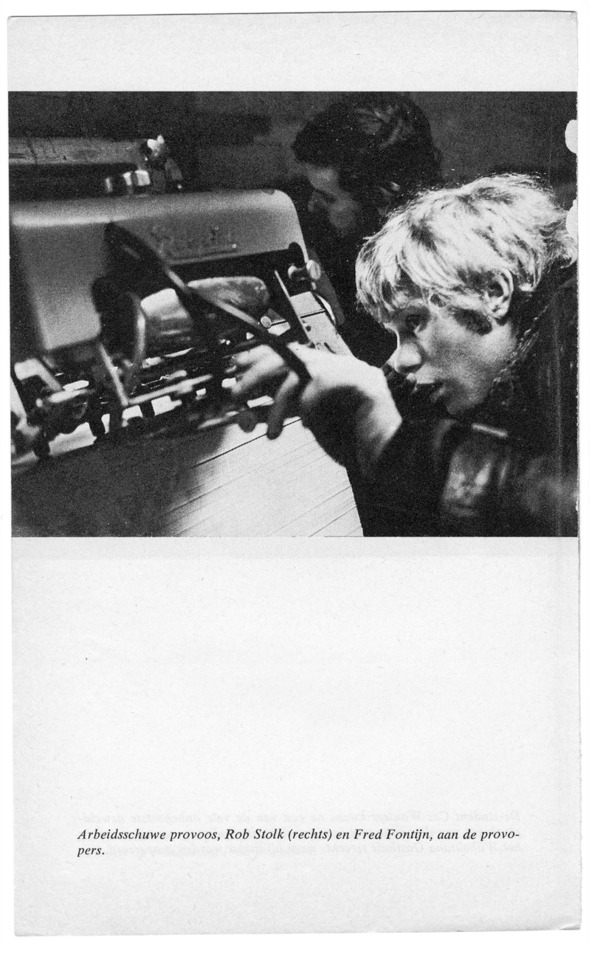
Printing press at Bloemstraat, Amsterdam (circa 1966). Page from ‘Het Witte Gevaar’ (Meulenhoff, 1967). The caption reads “Work-shy Provos, Rob Stolk (in the foreground) and Fred Fontijn (in the background), operating the Provo press”.
On printing Provo
‘Je Bevrijden van de Drukpers’ (‘To Liberate Yourself from the Printing Press’) was a Dutch article published in 1991 in the magazine ‘Jeugd en Samenleving’ (‘Youth and Society’). Written by the archivist, activist and artist Tjebbe van Tijen, the article featured interviews with a selection of people that were, each in their own way, involved in the printing of independent youth magazines. One of the persons being interviewed was Rob Stolk. What follows is a translation of the full interview.
Provo 1965–1967
I never attended a school for printing, so I wasn’t fully aware of all the possibilities available for publishing pamphlets. And if you aren’t aware of that, there’s only one thing you’re focused on, and that’s the costs. When you have an idealistic background, and you want to publish printed matter (an anti-war pamphlet, for example), it basically means that you won’t recover your money.
My first produced pamphlet was related to the activities we undertook as pacifist-socialist youngsters. We used a stencil duplicator (mimeograph machine) owned by a comrade of the PSP [Pacifist Socialist Party] at his place on the Westzijde in Zaandam. That thing was ancient, you had to operate it manually. If we wanted to add something fancy, like an illustration, we had to order a ‘photo stencil’, as we didn’t own a stencil-making machine ourselves. A stencil like that costed us seven and a half guilders, a considerable sum in those days. We picked up those stencils in Amsterdam, at the Spuistraat.
When we mimeographed the first issue of Provo, we were offered the use of the machine of mister De Groot, a subscriber to ‘Recht voor Allen’ [a Dutch anarcho-socialist magazine, originally founded in 1879], who had one of those machines standing in his attic. We were printing there until the early hours. That guy really enjoyed that he could support us that way. He had always hoped that a new generation would keep his ideals alive.
The first issue of Provo was mimeographed in an edition of 500, of which approximately 100 copies were actually distributed. The rest was confiscated by the police because of a text on how to manufacture bombs, a 19th century nonsense article that came illustrated with a glued-in firecracker. This immediately meant that there was enormous demand for the second issue. We printed 2000 of those; a gigantic task. Part of that edition was eventually printed at Roneo in the Spuistraat. Imagine those guys dressed in tidy suits and grey dust-coats, printing our magazine surrounded by office machines.
At a certain point, we started relocating our stencil machine. We had so much trouble with pamphlets being confiscated, because of insults to the queen and pranks like that – we just had to keep on moving the machine.
One time, we were printing an issue of Provo in a tiny room in the Staatsliedenbuurt, in the house of a lady who had no idea what the magazine was about, but she assumed it was alright since her son was involved. I was constantly dragging suitcases and piles of paper around; nobody knew the location of the machine but me.
Very quickly, it became clear to us that the distribution of Provo was dependent only on our ability to produce it. The demand was huge. The public had no idea what these Provos were about, and much to everybody’s surprise, these kids also published a magazine! That was a huge difference compared to the previous image of ‘pleiners’, ‘dijkers’ and ‘nozems’ [Dutch youth cultures, comparable to mods, rockers and teddy boys], thugs no one really understood. In that sense, the Provos were perceived quite differently: at least, they published a magazine!
We then bought an offset press, and installed it in a tiny basement. That was in the Bloemstraat, at Henk Raaf’s place, who ran a small travel agency from there. This was around 1966. After the 10th of March [the riots during the wedding procession of Princess Beatrix and Claus von Amsberg], we were all arrested. The police had a rough idea where the press was located; they had the feeling that if they would manage to the confiscate the press, the trouble would be over – that’s the way they thought back then. It never occurred to them that the press would be located in a neat building, in the basement of a travel agency. They were searching for long-haired people who were walking in and out of houses carrying printed matter, but of course, carrying printed matter in and out of a traveling agency was considered to be very normal. So they never found that press.
The print run of later editions of Provo reached 10,000. These copies were paid for only partially. If a new issue of Provo rolled off the press, youngsters came by to take stacks of magazines with them. Loe/Lou van Nimwegen [responsible for the administrative part of the printing] gave them 25 copies each. They sold those copies for 70 cent or so, and had to pay us part of that. Some of these guys you never saw back, while others just kept on selling. Some of them sold a couple of hundred copies on a single day; they immediately had enough money on them for the whole month. Maybe that was the problem; there was not enough stimulus to keep things going. We also tried to distribute the magazine through Van Gelder. Maybe that was exactly the strength of the magazine: the fact that the supply never met the demand, so that it always stayed something of a curiosity. If you managed to get a copy, it was special. It was never professionally organized, in terms of distribution.
Swiftly setting a text is a difficult task. You always had to search for the right typewriter, with the best letter. You wanted to act quickly, so you didn’t want to rely on suppliers of professional typography. This meant that aesthetically, things could get problematic. But of course, this was exactly what made the design so specifically subcultural. It went against the commercial design of mainstream printed culture – a mainstream culture that was boring and annoying. True, within the Provo movement there were also designers who, within other contexts, designed beautiful things; costly productions that were in a different league compared to the printed matter of Provo. But then again, we never had the pretension to measure ourselves against that. Subversive printed matter simply wasn’t meant to be beautiful.
I have always operated from the absolute minimum of money and assets. The people who were participating in these publications didn’t have a dime to spare. The plan was to produce it as cheap as possible, and to distribute it as wide as possible.
It was around that time that, at magazines such as Hitweek, a new form of design came into existence – one that was very different from the design that was common at advertising agencies. Also, with the rise of offset printing, it was no longer the typesetter who performed the job according to the instructions of the client; instead, the whole discipline of design became separated from the printing. The offset plate became the medium that could be filled with images and typography completely independent of the printer’s typesetting case.
I once cooperated with Chris Hahn on a booklet that included photos by Koen Wessing, documenting the riots during Beatrix’ wedding. It was printed quite weakly, but that was because we had a tiny offset press that was impossible to apply any ink on. Although we screened (‘rasterized’) the images quite decently, especially considering the time, the machine just couldn’t pull it off. We printed it on A4 sheets – it was still a pretty neat publication for those days. But again, the costs and the proceeds didn’t match up. It just wasn’t organized well enough to sustain. That’s typical though for political projects: the distribution is geared mainly to get the publication to as many people as possible, not to get any money back.
Hitweek [a then ‘hip’ Dutch music magazine] was a commercial enterprise, where they took into consideration the costs, the office hours, the phone bills. If we would have produced Provo in such a way it would have had a larger reach, especially if we would have included music coverage. But there were a lot of people who weren’t into that. Roel van Duijn wasn’t exactly a fan of the Beatles. In the end, a magazine is a conspiracy of people who all have a say about it. And if these people don’t agree on a subject, the tendency is to keep that subject out of the magazine. Cooperation consists of that what you do together. It also depended on who was momentarily responsible for the content. This responsibility was handed over from person to person. In the beginning it was mainly Roel’s job, but if he dominated too much editorially, it was pulled from his hands. Which meant that he refused to take part in the following issue, resulting in a totally different editorial tone.
I always wanted to employ my own printing press, because I always longed to publish things, for example magazines like Bethaniënnieuws or Nieuwsmarkt [magazines affiliated with Aktiegroep Nieuwmarkt]. In my view, these initiatives could only be conceivable if you had your own printing press. If you have to work with budgets like these, with print runs like these, on initiatives like these, and it lasts for only one or two issues – it’s impossible to deal with. In the end, we could only continue our activities by trying to make money with printing; by taking on assignments. Added to that, we owned some money from selling the Provo archive. So we had some resources to continue printing. But it still remained a struggle to keep on going. Just look at the difficulties that Bluf [an ’80s squatting magazine] had, trying to sustain in a non-profit way.
On the rise of screen-printed posters, especially those designed in the ’60s by Ontbijt op Bed [a Provo-related group from Maastricht]:
These posters were of a beauty... Spectacular, wonderful, really incredible. So, just like Kees Graaf [printer of Ontbijt op Bed], I started screen-printing, but without the know-how and resources that he had.
The problem remained though: how to make a living…
On the rise of psychedelic posters, which also happened around that time:
That was something we had nothing to do with; this whole sphere of ‘alternative culture’... In our eyes, those posters were still commercial commodities. We did everything we could to avoid that scene. Which is why I also worked as a plasterer, doing construction work with Ronnie and Otto, because I’d rather do that than to print commercially. To me, printing was something sacred; it was my weapon, a way to manifest oneself, and to cause confusion.
More and more, I realized I didn’t want to stand in the foreground of the activities I participated in. That would have been very counterproductive as well: to give the impression that it was “always the same guys”. In that sense, Provo also became very counterproductive.
Everything that came after Provo had an easier time manifesting itself, because of the vacuum that Provo left behind. Provo stopped, but the ideas was still there, the newspapers took notice, there was a voice that wasn’t there before. People outside the official circuit were suddenly being heard. You only had to start a committee or group, and you were in the news. If people were agitated about certain issues, it was in the newspapers. Before Provo, that was unthinkable.
Apart from those printing companies who weren’t members of the Koninklijk Verbond van Drukkerijen [trade organization for printers] and artists printing independently, Provo was one of the first post-war presses that wasn’t being exploited as a commercial printing company. Many others followed that example.
After the liquidation of Provo, we handed over the press for 6000 guilders or so, which we used to pay off our debts at the paper suppliers. The press was passed on to ASVA [a left-wing student organization], who set up SSP, the Stichting Studentenpers [the Students’ Press]. The SSP still exists, but I don’t know if they are still affiliated with ASVA.
This whole counterculture of independent printers has more a political background than a cultural background, at least in The Netherlands. It was quite simple in those days to get hold of a cheap, reasonably functioning press. The bar to start a printing company wasn’t set so high: if you had a couple of thousand guilders, you had a pretty decent Rotaprint press. The clients weren’t so demanding, so all it took was a minimum of means.
If a client asks you to deliver a certain product, you have to deal with a totally different set of requirements than when you only have to meet your own requirements. If it’s your own initiative to publish something, then what matters most is the content, not the quality of printing. There was an urgency then to get the information out as quickly as possible, to as many readers as possible. In fact, I still believe that a simple text can be more important than the most intricate design. It is certainly possible to express something original, without it being printed perfectly. You should be able to look beyond the design.
It seems very clear to me that a country without a free press is a country that sucks, because it is a country that conceals things. A society in which people have the possibility to organize themselves freely, to express themselves freely, is always a better society. I am fully convinced that the free press is one of the most important forces behind the progress of human society.
Rob Stolk (as interviewed by Tjebbe van Tijen), Amsterdam 1991
Translated by Experimental Jetset, on the occasion of the EJ-curated exhibition ’Two or Three Things I Know About Provo’, as took place in 2011 at artists’ space W139 (Amsterdam).
The original (Dutch) version of this interview can be found on the website of the International Instititute of Social History (IISG), as well as on Tjebbe van Tijen’s own website (Imaginary Museum Projects).
Another excellent interview with Rob Stolk, again focusing on his authorship as a printer, can be found in the Spring issue of ‘OpNieuw’ (Volume 19, 2001). Written by Tineke Nijenhuis, this article focuses more on Rob’s role within various magazines that were published after Provo, during the Aktiegroep Nieuwmarkt period.
3 notes
·
View notes
Text
Decluttering thoughts
I’m not too sure where exactly to begin writing this because my thoughts have been extremely crowded recently. I attempted to clear this up, perhaps unsuccessfully, in terms of finding some resolution or peace with myself. Writing has not proved itself to appease, however unrelentingly I have scribbled in the past few days about worries both real and petty. To first account for my decision of putting this up here instead of my proxy for the few reasons being this is primarily text and the latter does not serve this purpose in its primary function; it also takes the formality out of the context that i wish to preserve; neither do I have to consider the relevance or ill-relevance of an image to match this murk for whichever image I choose will either be unequable in what I am trying to convey. In part, I owe this slightly pretentious formality to what I have been reading — it is fascinating to consider how what we read affects our manner of speech so readily, how we are such malleable creatures — most of which are academic, some incoherent and others dense but illuminating, all of which in their certain positives have momentarily assumed my speech as so. I have marked my prose with sub-headers, if you wish to skip the parts that less interest you, do feel free.
An indefinite break from social media
I have a couple of thoughts lately, which I refer to as contemplations because they involve an action or call to action which I am pondering over its necessity and consequence. Among it includes the consideration to do away with my proxy platform. This in part is due to a larger desire to distance myself from social media and go offline for an extended period — by this I mean an indefinite hiatus. Lately it has occurred to me that this pressure of visibility is unwarranted and unnecessary, even distracting to making good art or good work. It is something I could do without because neither my life nor my income depends on it (though I have no income to speak of currently.) If I am finding nothing meaningful in whatever I post and all these actions are in fact mere gestures, self-aggrandising and therefore possessing the power to do otherwise, should it not be without a question to do without so as to do better? Another of which stems from the inadequacy of the platform in presenting thought and coherence as I would like it. Owing to my obsessive natures in this respect, it is frustrating to deal with it all the time. So for those of you who read this will know then, that if my silence has become obvious, it is not without reason. I would then request for you to write to me instead, if you so wish to know how I am. Letters are most welcome, but the instantaneous messages over mobile devices will not be shunned either. This distance is aimed at breaking the attachments formed between my sense of self, time and occupation with the entrapment of social media and its dangers, folly, excessive — not friendships.
Academic woes: a headache basically
A rut that I have been within in the past couple of days has been with regards to my next essay. This predicament can be attributed to a few things that form my incoherence and hence no sense of direction in which to take for this essay. To provide context, I am researching on Orientalism in the 19th century. My initial idea was to compare and contrast ballet repertoires choreographed during the late 19th century to early 20th century, and their representation of the Orient/ Exotic/ Other through the female body. Ideally, this would create many opportunities for discussion: fear projected in terms of imperialism, or perhaps classism thereby leading to ornamentalism rather than Said’s Orientalism; the male gaze and the female nude as prevailing practices and the Orient is a means of perpetuating that rather than representing anything; using Freud’s analysis on dreams and the erotic to explore if perhaps the sexualisation and sensualisation of the exotic is a deeper desire concealed by the Europeans than necessarily a means of subjugating the Other, for the Other is perhaps merely a means in which to distance such desires from themselves as they would hope to preserve as pristine, godly, restrained.
But, not everything goes as we intend it to be. There is a sore lack of research on Orientalism in ballet, and a greater cavity in the archival footages of ballet in the past. In part, photography was only gaining momentum in its infancy and the acclaimed Diaghilev also made sure that no recording of his choreography was permitted. That poses the question: how do you write about ballet if you have yet to see it live for yourself, even if through a screen? I can only read about it, and as with all secondary accounts, they might not be entirely factual; and as with all theatrics, there is a habit of exaggeration in play that I expect no less of an extravagance like ballet. So right now I am left with the ballet-russes of the 20th century, not 19th century — and only one was extensively publicised and studied over (that being Schehezerade, inspired by the Arabian Nights), and perhaps Salome, but that is a biblical tale, not exactly about the Eastern culture at all. I ever thought of doing a cross study of ballet, painting and perhaps poetry or literature, but none quite inspires as much as my initial imperative.
A part of me also wishes to make study the psychological/ social use of the East to represent sensuality and sexuality during that time. Perhaps as time continues to pass, I will not have the liberty to be choosy about this. Having written all these down, I surprisingly might find a way around this. I shall first delve into the possibility of the latter as my directive and see if there are possibilities for such. It feels like such a huge task because there is so little written about it, which might be an optimistic thing, in terms of originality, yet it also places such immense pressure on validating the arguments. It could go right with this, or very very wrong. I have rambled too much about my homework, which I would assume, not even make much sense to anyone other than myself. But all this is cathartic in a way. Now moving on —
The New Year and Turning 21
It is the doubling of the new year and turning a year older that always somehow leaves me more troubled and reclusive during this period than one would perhaps expect of in the festivity of the new year. This year has proven more weighing than the others, and if you may ask what turning 21 feels like, I think I have an answer compared to any one who thinks there’s not much change. It is only those still amid transitionary states do they feel most deeply what the ‘coming-of-age’ truly entails. Most days I am rattled by the worries of finances, and the ability to manage it properly and more than just adequately. I admit that I have ridiculous savings plans that require me to eat myself but I am confident that they are not impossible. This ridiculous savings plan is a method of future planning because this will be my funding after I graduate and anticipate the few months that I need to fight very crazily hard to stay here. It is almost sickening to think that if I save half of my allowance every month, I would have only saved a year of my tuition fees by the time I graduate. But it also reveals to me how hard I need to make my education worthwhile and my time here more worthwhile than anyone else. I also loathe the financially-conscious me who has to opt out of everything because it just isn’t within my priority nor means to do so. If you read this, I am not asking for sympathies or what not, maybe just the courtesy of not talking about it because it is already on my mind 24/7 and I just don’t want to talk about it further.
Money is a very real and disgusting problem, but we cannot do away with it, that would require an upheaval of entire economies and world that we have long set in stone for ourselves to relinquish. So as always this still stands: to beat the system is to excel in it, and gain the freedom in which it will allow you the options to stay away from it. I spent New Year’s Eve and countdown vacuuming the house and changing my sheets, making my house clean after two weeks of holiday. It’s the reality that a celebration is momentary and there are more important things to see to — the celebration can perhaps wait until you are in the mood for it. While everyone is planning some big party and joyous thing, I’m just thinking if I should catch that movie cause it would cause money; if I should go for tea as a treat to myself but that would also cost unnecessarily which I can instead use for classes or something else; staying at home alone would seem too sad and sorry; maybe I should take my film camera out for the afternoon and explore London instead. (But I am looking forward to dinner with Lynn that evening.)
Yesterday, I wrote a list of goals for the year: things I wish to accomplish in this year. It is encouraging and motivating to have that list up on my desk wall. Let’s hope I do stick to realising them. And perhaps I should even do away with using the word ‘hope’ excessively, because it only provides excuses and consolation for when I do not actually accomplish anything. To also reduce the dependency on these words: ‘just’, ‘maybe’, ‘hope’.
Unemployment; recruitment is a pain
Currently still unemployed. It is disheartening when you can’t even get a temporary job under your school because it’s by a first come first serve basis — and though you think you would be the first when you reply to the email immediately, you’re just that few letters short of time. How shameless can one also get? Or which desperation drives us into. I applied for the same job which rejected my application last October because I really really want to work there. There is no reply and I only think of the worst lately. Next week, I tell myself to grit my teeth and go to a few places to ask if they have any part-time vacancies. I am crossing my fingers I get some good news with that. If I have this job, then I wouldn’t have to worry so much about finances. I also tell myself it is only 4 months since I’ve moved here and I need to give London some time, so time I will take. But recruitment, you really are a pain.
My thoughts have presently escaped me and I shall pause here till they return, should they ever. School reopens tomorrow and many things await but taking a step at a time. Adulthood is terrifying and burdensome and whoever thought of this vicious cycle is a maniac. (We are worse, for buying into it and living it.)
4 notes
·
View notes
Text
(Guide) How to Choose & Customize a Landing Page Template
Let’s say you’re the owner of a boutique soap store and you’re taking your business online. (Hey, in 2020, you wouldn’t be the only one.)
You’ve already got a simple website, but you wanna run promotions to really lather up some business. So, you get to work on your marketing campaign. You come up with an irresistible offer. You spend your lunch hours building an email list of existing and potential customers. You stay up late learning the basics of Google Ads. Then you start planning the landing page where you’ll send your campaign traffic.
With all the work you’ve already put in, you’re delighted to know you can save some time by starting with a landing page template. But when you go to choose one in your favorite builder (ahem), you don’t see any that look right for your business. There’s a template that seems like it’s meant for realtors, maybe. Another that’d be good for bakeries. But nothing for soap sellers like you. You’re stuck.
“Dangit, Unbounce. Where’re the soap landing pages?” — You, probably.
Not so fast, sudsy—you’re looking at this the wrong way. The idea here isn’t to find a landing page template that matches your business exactly. First and foremost, you want to choose a template that supports your campaign conversion goal. Everything else—your industry, your product or service, your branding—comes second.
In this post, we’ll show you how to pick out the perfect template for your next marketing campaign. Then, we’ll show you how you can transform it into a custom-branded, high-converting masterpiece.
How to Choose a Template That Supports Your Conversion Goal
What’s a conversion goal, exactly?
Your conversion goal is the action you want visitors to take as a result of your marketing campaign. Maybe you want somebody to buy a product, like fancy soap. Or maybe you want them to sign up for a webinar about… I dunno, making fancy soap?
The point is that some landing page templates are better-suited to specific conversion goals than others. If you just want someone to buy a product, your landing page’s call to action is pretty straightforward. On the other hand, if you’re registering people for a webinar, you’re gonna need their name and email address (at least). That’ll mean a more complex call to action.
Which template is best for your conversion goal?
Broadly, landing page templates fall into one of two categories: click-through pages and lead generation pages. They’ve each got a distinct type of call to action meant to support a certain conversion goal.
The page on the left is a click-through landing page, while the one on the right is a lead gen landing page.
Click-through landing pages prime visitors for the next step in their journey, like a checkout flow or sign-up page. Since the real ask comes wherever they end up after this page, the call to action here is simple—usually just a button. (“Buy Now” is a classic of this genre.)
On the other hand, lead generation landing pages use forms to capture visitor information that can be used later, like for promotional emails. These pages typically offer some kind of incentive (or “lead magnet”) for filling out the form—a downloadable ebook or webinar registration, for example.
What about the design of a template?
First, you need to decide whether your conversion goal requires a click-through or lead gen landing page. Then, consider how the template’s design spotlights your offer.
If you’re selling soap, you probably want a click-through template that can accommodate lots of photos of your product, like this one. And maybe you think that soap-making webinar we suggested earlier sounds like a great idea. You might want a lead gen template that can share a video of what people can expect, like this one.
Notice that neither of these templates have anything to do with soap. We chose ’em because their call to action supports our conversion goal and their design reinforces our offer. Now, we can start to replace elements of these pages with our own copy and imagery to integrate them into our marketing campaign.
Converting a Landing Page Template for Your Campaign
Every landing page template is different, but they usually have similar elements and follow the same general structure: a header section, a list of features and benefits, some social proof, and a call to action. (Also check out this post on the anatomy of a landing page.)
Follow the steps below to transform your chosen template into a branded landing page that’ll win over your visitors.
1. Your Header Section
Add a hero image of your product, service, or lead magnet. If you want to help prospects visualize the benefits, consider showing your offer in the context of use: someone using your product to solve a problem or improving themselves through your service.
Be sure to include your company logo. You want people to know this is your landing page, after all.
Write a descriptive headline that tells people exactly what you’re offering. You can also communicate your main value proposition using a couple of sentences just under your headline.
Update your call to action. If you’re using a click-through template, you could have a button that sends people to a product page on your website, a third-party delivery platform, or even add a Shopify integration. If you’re capturing leads, try to keep your form simple—only ask for the information you absolutely need.
This header from Promo (featured in our post on high-converting landing page examples) communicates their offer super clearly.
2. Your Benefits Section
People skim, so provide a bulleted list of the benefits of your offer. If you’re creating a sales page, use this space to highlight how your product or service improves your customers’ lives. If you’re offering a lead magnet (like an ebook), tell people what they’ll learn and how they can apply it.
Does your template have icons for each benefit? Make sure they’re relevant to your offer or brand. If not, lots of websites offer free icons you can use to replace ‘em: streamlineicons.com, flaticon.com, thenounproject.com, material.io, icons8.com, ionicons.com, among others.
3. Your Social Proof Section
Include a testimonial from a satisfied customer, or maybe an endorsement from an industry leader. The trick here is authenticity: use a real quote that sounds believable. Even real testimonials that are too positive can sound like you’re making ‘em up.
Alternatively, you could showcase other kinds of proof: awards you’ve won, trust seals you’ve earned—that sorta thing.
Whatever you include here, remember to ask permission. For example, depending on where you source a testimonial from (Amazon, G2), there may be restrictions on how you can use it.
4. Your About Section
Let people know more about your business. What makes your product or service unique? What’s your mission statement—your raison d’être? This is your opportunity to connect with visitors beyond this particular offer.
That said, you don’t want visitors to lose focus. Keep it short and sweet.
Coco Village (who we highlighted in our post on the best landing page examples) blends social proof with their own parenting philosophy.
5. Your CTA Section
If your page runs long, consider including a final pitch for your offer. This is your last chance, so make it count. Pump up the urgency or exclusivity, or remind visitors about the benefits they stand to gain—whatever it takes to get the conversion.
Repeat the call to action button from your header section. Or, if this is a lead gen page, include a button that bumps visitors back up to your form.
6. Your Footer Section
Add your logo and any other details you need to communicate (contact information, copyright notice, any other necessary boilerplate) at the very bottom of the page.
And that about covers it. With that quick checklist, you can turn just about any template into an on-brand landing page in just a few minutes. Simple, right?
3 (More) Examples of Landing Page Template Customization
Alright, the soap example is feeling a little played out. Now, let’s take three templates that Unbounce put together in response to COVID-19 earlier this year—FreshGoods, Multor, and Horizons—and switch ‘em up for different industries.
You can do all of this yourself, of course. But just to make sure these examples are absolute fire, I’ve recruited Gus from our design team to help out.
Gus says “what’s up,” by the way.
FreshGoods → UNIQ
First up is FreshGoods, a click-through landing page template that was designed to help brick-and-mortars get online super quick. Small retailers that don’t have a website can use it to launch a basic ecomm page. Restaurants and breweries can use it to link out to delivery platforms or run special promotions. But it can also fit a more general product launch page—say, for a new mobile app.
The design for FreshGoods clearly speaks to a bakery or cafe. You’ve got the hero image of a bread basket, secondary photography of hand-made pastries and specialty coffees, plus icons that imply food delivery.
The original version of FreshGoods. (Click to see the whole thing.)
But what’s great about FreshGoods is that it’s both simple and comprehensive. You’ve got all the sections you need to communicate your offer in a compelling way, without any of the technical design elements you’d need to spend hours tinkering with.
Changing it up is super easy. You’ve really just gotta swap in your logo, images, and icons—then you’ve got (what looks like) a totally custom landing page.
The new landing page we built with FreshGoods. (Click to see the whole thing.)
Sure, when you compare the two pages side-by-side, you can see they’re similar. But think about the amount of real work that went into this. Swapping in the new logo? Two minutes. Sourcing images… say 10 minutes. (Or even less, considering our in-app integration with Unsplash.) Add a couple other minor tweaks, and what you’re looking at is, like, 20 minutes for a whole new page.
All you’ve gotta do now is write your campaign copy. (And if you want tips on how to write for your industry, you can pull some insights from our Conversion Benchmark Report.)
Multor → PersonalTrainer
The idea for the Multor lead gen template was to help businesses offer digital alternatives to their in-person services. Healthcare clinics and dentists can use it to offer online consultations. Realtors can schedule people for virtual home walkthroughs. Fitness instructors can register people for video classes… which gives us a great idea for a new page.
We’ll get to that in a second, but let’s have a look at the original page first. Multor Senior feels pretty Silicon Valley, right? It’s all photos of people on computers. (We even snuck a coffee in there, which is very tech.) And the blue is evoking logic and dependability. Look, there it goes!
The original version of Multor. (Click to see the whole thing.)
Like FreshGoods, Multor is meant to be easily customizable. To create our new fitness landing page, we just added our logo and hero image, changed the icons, and replaced the old photos and video. Then we tinkered with some of the fonts, colors, and backgrounds.
The new landing page we built with Multor. (Click to see the whole thing.)
Lo and behold—we’ve got a whole new page in less time than it takes to finish your morning cup’a joe.
Horizons → MKT Masters
With the Horizons template, we wanted to help brands capture leads and for promotions during a down period. Think travel and hospitality companies that wanna get people booked for events next year, or marketing agencies hoping to attract business with an ebook or webinar.
The original version of Horizons. (Click to see the whole thing.)
You’ll see that the design fits some kind of outdoorsy company, what with the photos of nature and delightful orienteering icons. We’d originally mocked up the page for a downloadable ebook, but this template is great for any kind of lead magnet.
How about… an online class all about great marketing, hosted by future me?
The new landing page we built with Horizons. (Click to see the whole thing.)
We went a little bit wild with this one. In addition to changing up the imagery and colors, we decided to rearrange the sections to have our video just under the fold. That way, the first thing visitors will see when they scroll the page is a preview of our class—the most compelling piece of promo material we’ve got.
Create Your Next Landing Page with a Quick-Start Template
Are you still building your landing pages from scratch? (Or, worse yet, relying on a developer to code ‘em for you?)
Forget that. Using one of Unbounce’s 100+ templates, you can put together a fully-branded, campaign-customized landing page in just a few minutes. That means you can spend less time creating pages and more time creating artisanal soaps—or, y’know, whatever else you wanna do with your time.
Go on—give it a shot.
(Guide) How to Choose & Customize a Landing Page Template published first on https://nickpontemrktg.wordpress.com/
0 notes
Text
Four Simple Ways to Inject Humor into Your Local Marketing
“Humor is subjective,” is something we’ve all heard.
What’s funny to you might not be funny to someone else, sure. But subjectivity only refers to the effect of comedy, not the construction of it.
There are ways to inject humor into your marketing agency strategy that are almost certain to make people laugh.
If you’ve determined that your local business needs humor to make it stick in the minds of its target audience, then you need to know where to start and what to do next.
In this article I will present four different approaches to help inject humor into your local marketing agency:
The Irreverent Approach
The Meme Approach
The Meta Approach
The Satirical Approach
You might be wondering, “what do these terms mean?” And more importantly, how can they be used to make your local marketing agency campaign stand out from the competition?
Providing you’ve taken the relevant data into account (and determined whether or not this kind of approach will appeal to your best-fit user personas), humor can be a great route to go down.
So, without further ado, I present the four primary approaches.
The Irreverent Approach
To be irreverent you need to, to put it simply, be a little ‘weird’ and a bit edgy. The all-knowing wisdom provider known as Google defines ‘irreverent’ as: ‘Showing a lack of respect for people or things that are generally taken seriously.’
Your first thought when hearing this may be, “When would it make sense for a business to disrespect the people they are trying to woo?” In an age where nine out of ten customers research a business before buying from them, that’s the very last thing a business would want to do, right?
Well, being irreverent with your marketing agency’s humor can work if it’s done right. Look no further than the Twitter account of US-based fast food chain, Wendy’s. Their Twitter account presents itself as if it’s moderated by someone with zero professional scruples. But the important thing is, it makes people laugh and makes them remember the brand.
Of course, whether you can use this approach depends hugely on your target audience. If you are looking to engage younger audiences, and your products are not inherently “serious” (think YMYL websites), you can afford to have a little fun. In short: if you are selling burgers, irreverent humor can work. Pharmaceuticals, less so.
Source: Twitter
But despite the seemingly dismissive and immature attitude of Wendy’s’ Twitter, it gets excellent engagement from users (many of whom actually appreciate their irreverent humor) and millions of people eat at their establishments every day. It’s a prime example of how such irreverent humor can actually be long-lasting and financially beneficial for a business.
So, how did Wendy’s do it? Simple — it’s all about the attitude. Even though their Twitter posts and other marketing agency gimmicks may appear to be immature and even rude, it’s also clearly all done from a place of jest.
Now I’m not necessarily jumping in at the deep end and going full Wendy’s but, ultimately, this kind of irreverent approach could inspire you to take more risks with your humor and thus stand out from the competition.
Just make sure that you get the tone right, and remember this approach will depend greatly on:
a) your target audience b) your existing brand image and standing, and c) how well it is executed
As I’ve discussed, irreverent marketing agency works well with some groups, and less well with others. Try not to make light of a serious subject, but you can have some fun with products that your target audience knows and loves.
When it comes to local advertising, businesses have a real advantage in using this approach: your customers share knowledge of your area, town, or city. Gently poking fun at local landmarks, customs, or jokes can be a great way to show your customers that you are engaged in the local community and that you’re a true local.
The Meme Approach
The ‘meme approach’ is a highly overlooked marketing agency strategy by most businesses, even though there are several big brands that have used it to great effect. Memes are silly, of course, but they can have a pretty serious effect on your brand image if used correctly.
What is a meme? According to Dictionary.com, a meme is: ‘a cultural item in the form of an image, video, phrase, etc., that is spread via the Internet and often altered in a creative or humorous way.’
Here’s a classic meme, albeit one that is showing its age:
Source: Wikipedia
Today, memes come in all shapes and sizes, so you can easily find one that speaks to your audience. Because of this, memes can also be highly effective in local marketing agency, but in order to market memes successfully, you need to appeal to their target audience and understand their context. This will require an intelligent comprehension of the modern cultural landscape.
Let’s take a look at Netflix as an example because, while they may not be local, as a company they really understand how to use memes to position themselves as a contemporary brand. Their approach may not seem like a traditional outreach marketing agency strategy, but using memes as part of your overall marketing agency strategy can pay off when executed right.
Source: Twitter
Netflix’s meme knowledge and how they’ve used it to market their content is plentiful, but perhaps the shining example of their viral marketing agency style was what happened with the Sandra Bullock film, Bird Box. Memes centering on the apocalyptic plot of the film began popping up on social media in December 2018.
The impact of these promotional memes skyrocketed the film’s success, and even the Bird Box meme went on to have a life of its own in the ensuing months with the advent of the controversial ‘Bird Box Challenge’, where people blindfolded themselves like in the movie and then went about their daily business.
Additionally, rather than clamp down on overseas viewers and shared accounts, Netflix actually does the opposite – openly acknowledging the use of shared accounts and “Netflix VPNs” which circumvent content restrictions. The company’s use of memes on social media has such high engagement rates that it’s become a thing of legend, which other brands have sought to replicate.
If you want to market with memes, you have to understand them. Every meme has a joke at the center of it, and every instance of the said meme is a variation of that joke. Every meme is different, and to successfully promote your business with them, you need to know how they’re different.
You also need to isolate how the meme you’ve chosen relates to your brand. Know the brand, know the memes, and mix and match to find the best coupling.
Local businesses can adapt existing memes to reflect their geographical location. In fact, for local advertising, it is pretty easy to find a trending meme, and with a little creativity adapt it for local customers. In some ways, using memes in local advertising is easier than in national-level campaigns, because you know exactly who you are talking to, and the in-jokes that apply to your area.
The Meta Approach
If you are of sound mind, then you are aware that what you are reading right now is an article. Most articles hide behind the fourth wall of objectivity for the purpose of laying out information and facts in an orderly, educated, and formal manner that never goes off-topic in order to deconstruct itself.
marketing agency exercises this same approach most of the time. We tend to present the product directly and lay out the details and features in an informational fashion without calling attention to any promos as specific advertising.
If you choose to use a humorous approach in your local marketing agency strategy, flipping the script and using the meta advertising strategy may be the ticket to attracting your targeted customer base. A commercial that acknowledges itself as a commercial is a refreshing flourish of “truth in advertising” that’s been a growing trend in marketing agency circles over the latter half of the last decade.
One company that has taken full advantage of the lucrative potential of self-awareness is the UK-based Hosting Data, which specializes in building online identities for UK citizens. Its founder, Alex Williams, uses the informative and informal tone of his personality to fuel his company’s self-referential local marketing agency strategy.
What better way to sell the idea of selling yourself online than to sell yourself online using a tinge of dry, British humor (if you’re British, that is)? That’s exactly what Williams does with his humorous meta approach to his business.
For local businesses, using a meta approach means one thing: being self-aware of where you are based. If you are based in a small town, make your customers aware of the pride you take in being a small-town company. If you are from a large city, it can pay to integrate your location not only into your social media content but even your logo or brand name.
People love to buy local, as long as they feel that doing so is a way of boosting pride in their local community.
The Satirical Approach
Satire is neither for the small-minded nor the closed-minded. People can often miss the point or misinterpret the intention.
Most individuals with refined humoristic palates look upon such irrational reactions to satire with gleeful schadenfreude. The misunderstanding of satire has become an intellectual spectator sport where we scroll through social media sites, and read along with our jaws agape at comment threads where some individuals seem to think spam filters are found in the canned food sections of supermarkets.
But in these kinds of feeds, we also might find an ad for one of your agency’s clients where they’ve used a cheeky play on words. That may sound irreverent, but satire requires a particular execution of irreverence. If your local business client wants to use satire in their marketing agency or content, they need a clear line of sight on who they’re targeting, and the humor must be spun in a refreshing and innovative manner.
One example is the 2014 ‘Power of the Book Book Ad’ marketing agency campaign that was launched by the retail furniture company Ikea. This campaign took a satirical approach, targeted at another not-so-little-known company called Apple and their iPad technology.
youtube
Through this approach, Ikea promoted the release of its catalog as if it were a sleek, top of the line, blockbuster product, just like something that would be released by tech giants Apple. Ikea took all the sincere elements of an Apple ad and turned them upside down in an ironically backhanded way.
How do we know that this approach worked for Ikea? Simple — they keep doing it. A golden rule of marketing agency is that if something works and is giving you a good return on investment, keep doing it until it doesn’t work anymore. A business that actually calculates its ROI has a 72% chance that it has an effective marketing agency strategy.
But no one can accurately predict the final result, so you should always weigh the pros and cons of each considered approach before pulling the trigger on it.
To use satire in a local marketing agency strategy, not only do you have to know your audience, you have to know your rivals. A good company knows where their bread is buttered, so take a look at the content being used by your local rivals. You can then (gently) satirize their content, which will simultaneously indicate that you don’t take your own brand too seriously whilst giving your local customers a good joke to share.
The post Four Simple Ways to Inject Humor into Your Local Marketing appeared first on BrightLocal.
Website Design & SEO Delray Beach by DBL07.co
Delray Beach SEO
source http://www.scpie.org/four-simple-ways-to-inject-humor-into-your-local-marketing/ source https://scpie1.blogspot.com/2020/07/four-simple-ways-to-inject-humor-into.html
0 notes
Text
Four Simple Ways to Inject Humor into Your Local Marketing
“Humor is subjective,” is something we’ve all heard.
What’s funny to you might not be funny to someone else, sure. But subjectivity only refers to the effect of comedy, not the construction of it.
There are ways to inject humor into your marketing agency strategy that are almost certain to make people laugh.
If you’ve determined that your local business needs humor to make it stick in the minds of its target audience, then you need to know where to start and what to do next.
In this article I will present four different approaches to help inject humor into your local marketing agency:
The Irreverent Approach
The Meme Approach
The Meta Approach
The Satirical Approach
You might be wondering, “what do these terms mean?” And more importantly, how can they be used to make your local marketing agency campaign stand out from the competition?
Providing you’ve taken the relevant data into account (and determined whether or not this kind of approach will appeal to your best-fit user personas), humor can be a great route to go down.
So, without further ado, I present the four primary approaches.
The Irreverent Approach
To be irreverent you need to, to put it simply, be a little ‘weird’ and a bit edgy. The all-knowing wisdom provider known as Google defines ‘irreverent’ as: ‘Showing a lack of respect for people or things that are generally taken seriously.’
Your first thought when hearing this may be, “When would it make sense for a business to disrespect the people they are trying to woo?” In an age where nine out of ten customers research a business before buying from them, that’s the very last thing a business would want to do, right?
Well, being irreverent with your marketing agency’s humor can work if it’s done right. Look no further than the Twitter account of US-based fast food chain, Wendy’s. Their Twitter account presents itself as if it’s moderated by someone with zero professional scruples. But the important thing is, it makes people laugh and makes them remember the brand.
Of course, whether you can use this approach depends hugely on your target audience. If you are looking to engage younger audiences, and your products are not inherently “serious” (think YMYL websites), you can afford to have a little fun. In short: if you are selling burgers, irreverent humor can work. Pharmaceuticals, less so.
Source: Twitter
But despite the seemingly dismissive and immature attitude of Wendy’s’ Twitter, it gets excellent engagement from users (many of whom actually appreciate their irreverent humor) and millions of people eat at their establishments every day. It’s a prime example of how such irreverent humor can actually be long-lasting and financially beneficial for a business.
So, how did Wendy’s do it? Simple — it’s all about the attitude. Even though their Twitter posts and other marketing agency gimmicks may appear to be immature and even rude, it’s also clearly all done from a place of jest.
Now I’m not necessarily jumping in at the deep end and going full Wendy’s but, ultimately, this kind of irreverent approach could inspire you to take more risks with your humor and thus stand out from the competition.
Just make sure that you get the tone right, and remember this approach will depend greatly on:
a) your target audience b) your existing brand image and standing, and c) how well it is executed
As I’ve discussed, irreverent marketing agency works well with some groups, and less well with others. Try not to make light of a serious subject, but you can have some fun with products that your target audience knows and loves.
When it comes to local advertising, businesses have a real advantage in using this approach: your customers share knowledge of your area, town, or city. Gently poking fun at local landmarks, customs, or jokes can be a great way to show your customers that you are engaged in the local community and that you’re a true local.
The Meme Approach
The ‘meme approach’ is a highly overlooked marketing agency strategy by most businesses, even though there are several big brands that have used it to great effect. Memes are silly, of course, but they can have a pretty serious effect on your brand image if used correctly.
What is a meme? According to Dictionary.com, a meme is: ‘a cultural item in the form of an image, video, phrase, etc., that is spread via the Internet and often altered in a creative or humorous way.’
Here’s a classic meme, albeit one that is showing its age:
Source: Wikipedia
Today, memes come in all shapes and sizes, so you can easily find one that speaks to your audience. Because of this, memes can also be highly effective in local marketing agency, but in order to market memes successfully, you need to appeal to their target audience and understand their context. This will require an intelligent comprehension of the modern cultural landscape.
Let’s take a look at Netflix as an example because, while they may not be local, as a company they really understand how to use memes to position themselves as a contemporary brand. Their approach may not seem like a traditional outreach marketing agency strategy, but using memes as part of your overall marketing agency strategy can pay off when executed right.
Source: Twitter
Netflix’s meme knowledge and how they’ve used it to market their content is plentiful, but perhaps the shining example of their viral marketing agency style was what happened with the Sandra Bullock film, Bird Box. Memes centering on the apocalyptic plot of the film began popping up on social media in December 2018.
The impact of these promotional memes skyrocketed the film’s success, and even the Bird Box meme went on to have a life of its own in the ensuing months with the advent of the controversial ‘Bird Box Challenge’, where people blindfolded themselves like in the movie and then went about their daily business.
Additionally, rather than clamp down on overseas viewers and shared accounts, Netflix actually does the opposite – openly acknowledging the use of shared accounts and “Netflix VPNs” which circumvent content restrictions. The company’s use of memes on social media has such high engagement rates that it’s become a thing of legend, which other brands have sought to replicate.
If you want to market with memes, you have to understand them. Every meme has a joke at the center of it, and every instance of the said meme is a variation of that joke. Every meme is different, and to successfully promote your business with them, you need to know how they’re different.
You also need to isolate how the meme you’ve chosen relates to your brand. Know the brand, know the memes, and mix and match to find the best coupling.
Local businesses can adapt existing memes to reflect their geographical location. In fact, for local advertising, it is pretty easy to find a trending meme, and with a little creativity adapt it for local customers. In some ways, using memes in local advertising is easier than in national-level campaigns, because you know exactly who you are talking to, and the in-jokes that apply to your area.
The Meta Approach
If you are of sound mind, then you are aware that what you are reading right now is an article. Most articles hide behind the fourth wall of objectivity for the purpose of laying out information and facts in an orderly, educated, and formal manner that never goes off-topic in order to deconstruct itself.
marketing agency exercises this same approach most of the time. We tend to present the product directly and lay out the details and features in an informational fashion without calling attention to any promos as specific advertising.
If you choose to use a humorous approach in your local marketing agency strategy, flipping the script and using the meta advertising strategy may be the ticket to attracting your targeted customer base. A commercial that acknowledges itself as a commercial is a refreshing flourish of “truth in advertising” that’s been a growing trend in marketing agency circles over the latter half of the last decade.
One company that has taken full advantage of the lucrative potential of self-awareness is the UK-based Hosting Data, which specializes in building online identities for UK citizens. Its founder, Alex Williams, uses the informative and informal tone of his personality to fuel his company’s self-referential local marketing agency strategy.
What better way to sell the idea of selling yourself online than to sell yourself online using a tinge of dry, British humor (if you’re British, that is)? That’s exactly what Williams does with his humorous meta approach to his business.
For local businesses, using a meta approach means one thing: being self-aware of where you are based. If you are based in a small town, make your customers aware of the pride you take in being a small-town company. If you are from a large city, it can pay to integrate your location not only into your social media content but even your logo or brand name.
People love to buy local, as long as they feel that doing so is a way of boosting pride in their local community.
The Satirical Approach
Satire is neither for the small-minded nor the closed-minded. People can often miss the point or misinterpret the intention.
Most individuals with refined humoristic palates look upon such irrational reactions to satire with gleeful schadenfreude. The misunderstanding of satire has become an intellectual spectator sport where we scroll through social media sites, and read along with our jaws agape at comment threads where some individuals seem to think spam filters are found in the canned food sections of supermarkets.
But in these kinds of feeds, we also might find an ad for one of your agency’s clients where they’ve used a cheeky play on words. That may sound irreverent, but satire requires a particular execution of irreverence. If your local business client wants to use satire in their marketing agency or content, they need a clear line of sight on who they’re targeting, and the humor must be spun in a refreshing and innovative manner.
One example is the 2014 ‘Power of the Book Book Ad’ marketing agency campaign that was launched by the retail furniture company Ikea. This campaign took a satirical approach, targeted at another not-so-little-known company called Apple and their iPad technology.
youtube
Through this approach, Ikea promoted the release of its catalog as if it were a sleek, top of the line, blockbuster product, just like something that would be released by tech giants Apple. Ikea took all the sincere elements of an Apple ad and turned them upside down in an ironically backhanded way.
How do we know that this approach worked for Ikea? Simple — they keep doing it. A golden rule of marketing agency is that if something works and is giving you a good return on investment, keep doing it until it doesn’t work anymore. A business that actually calculates its ROI has a 72% chance that it has an effective marketing agency strategy.
But no one can accurately predict the final result, so you should always weigh the pros and cons of each considered approach before pulling the trigger on it.
To use satire in a local marketing agency strategy, not only do you have to know your audience, you have to know your rivals. A good company knows where their bread is buttered, so take a look at the content being used by your local rivals. You can then (gently) satirize their content, which will simultaneously indicate that you don’t take your own brand too seriously whilst giving your local customers a good joke to share.
The post Four Simple Ways to Inject Humor into Your Local Marketing appeared first on BrightLocal.
Website Design & SEO Delray Beach by DBL07.co
Delray Beach SEO
source http://www.scpie.org/four-simple-ways-to-inject-humor-into-your-local-marketing/ source https://scpie.tumblr.com/post/625041718475145216
0 notes
Text
Four Simple Ways to Inject Humor into Your Local Marketing
“Humor is subjective,” is something we’ve all heard.
What’s funny to you might not be funny to someone else, sure. But subjectivity only refers to the effect of comedy, not the construction of it.
There are ways to inject humor into your marketing agency strategy that are almost certain to make people laugh.
If you’ve determined that your local business needs humor to make it stick in the minds of its target audience, then you need to know where to start and what to do next.
In this article I will present four different approaches to help inject humor into your local marketing agency:
The Irreverent Approach
The Meme Approach
The Meta Approach
The Satirical Approach
You might be wondering, “what do these terms mean?” And more importantly, how can they be used to make your local marketing agency campaign stand out from the competition?
Providing you’ve taken the relevant data into account (and determined whether or not this kind of approach will appeal to your best-fit user personas), humor can be a great route to go down.
So, without further ado, I present the four primary approaches.
The Irreverent Approach
To be irreverent you need to, to put it simply, be a little ‘weird’ and a bit edgy. The all-knowing wisdom provider known as Google defines ‘irreverent’ as: ‘Showing a lack of respect for people or things that are generally taken seriously.’
Your first thought when hearing this may be, “When would it make sense for a business to disrespect the people they are trying to woo?” In an age where nine out of ten customers research a business before buying from them, that’s the very last thing a business would want to do, right?
Well, being irreverent with your marketing agency’s humor can work if it’s done right. Look no further than the Twitter account of US-based fast food chain, Wendy’s. Their Twitter account presents itself as if it’s moderated by someone with zero professional scruples. But the important thing is, it makes people laugh and makes them remember the brand.
Of course, whether you can use this approach depends hugely on your target audience. If you are looking to engage younger audiences, and your products are not inherently “serious” (think YMYL websites), you can afford to have a little fun. In short: if you are selling burgers, irreverent humor can work. Pharmaceuticals, less so.
Source: Twitter
But despite the seemingly dismissive and immature attitude of Wendy’s’ Twitter, it gets excellent engagement from users (many of whom actually appreciate their irreverent humor) and millions of people eat at their establishments every day. It’s a prime example of how such irreverent humor can actually be long-lasting and financially beneficial for a business.
So, how did Wendy’s do it? Simple — it’s all about the attitude. Even though their Twitter posts and other marketing agency gimmicks may appear to be immature and even rude, it’s also clearly all done from a place of jest.
Now I’m not necessarily jumping in at the deep end and going full Wendy’s but, ultimately, this kind of irreverent approach could inspire you to take more risks with your humor and thus stand out from the competition.
Just make sure that you get the tone right, and remember this approach will depend greatly on:
a) your target audience b) your existing brand image and standing, and c) how well it is executed
As I’ve discussed, irreverent marketing agency works well with some groups, and less well with others. Try not to make light of a serious subject, but you can have some fun with products that your target audience knows and loves.
When it comes to local advertising, businesses have a real advantage in using this approach: your customers share knowledge of your area, town, or city. Gently poking fun at local landmarks, customs, or jokes can be a great way to show your customers that you are engaged in the local community and that you’re a true local.
The Meme Approach
The ‘meme approach’ is a highly overlooked marketing agency strategy by most businesses, even though there are several big brands that have used it to great effect. Memes are silly, of course, but they can have a pretty serious effect on your brand image if used correctly.
What is a meme? According to Dictionary.com, a meme is: ‘a cultural item in the form of an image, video, phrase, etc., that is spread via the Internet and often altered in a creative or humorous way.’
Here’s a classic meme, albeit one that is showing its age:
Source: Wikipedia
Today, memes come in all shapes and sizes, so you can easily find one that speaks to your audience. Because of this, memes can also be highly effective in local marketing agency, but in order to market memes successfully, you need to appeal to their target audience and understand their context. This will require an intelligent comprehension of the modern cultural landscape.
Let’s take a look at Netflix as an example because, while they may not be local, as a company they really understand how to use memes to position themselves as a contemporary brand. Their approach may not seem like a traditional outreach marketing agency strategy, but using memes as part of your overall marketing agency strategy can pay off when executed right.
Source: Twitter
Netflix’s meme knowledge and how they’ve used it to market their content is plentiful, but perhaps the shining example of their viral marketing agency style was what happened with the Sandra Bullock film, Bird Box. Memes centering on the apocalyptic plot of the film began popping up on social media in December 2018.
The impact of these promotional memes skyrocketed the film’s success, and even the Bird Box meme went on to have a life of its own in the ensuing months with the advent of the controversial ‘Bird Box Challenge’, where people blindfolded themselves like in the movie and then went about their daily business.
Additionally, rather than clamp down on overseas viewers and shared accounts, Netflix actually does the opposite – openly acknowledging the use of shared accounts and “Netflix VPNs” which circumvent content restrictions. The company’s use of memes on social media has such high engagement rates that it’s become a thing of legend, which other brands have sought to replicate.
If you want to market with memes, you have to understand them. Every meme has a joke at the center of it, and every instance of the said meme is a variation of that joke. Every meme is different, and to successfully promote your business with them, you need to know how they’re different.
You also need to isolate how the meme you’ve chosen relates to your brand. Know the brand, know the memes, and mix and match to find the best coupling.
Local businesses can adapt existing memes to reflect their geographical location. In fact, for local advertising, it is pretty easy to find a trending meme, and with a little creativity adapt it for local customers. In some ways, using memes in local advertising is easier than in national-level campaigns, because you know exactly who you are talking to, and the in-jokes that apply to your area.
The Meta Approach
If you are of sound mind, then you are aware that what you are reading right now is an article. Most articles hide behind the fourth wall of objectivity for the purpose of laying out information and facts in an orderly, educated, and formal manner that never goes off-topic in order to deconstruct itself.
marketing agency exercises this same approach most of the time. We tend to present the product directly and lay out the details and features in an informational fashion without calling attention to any promos as specific advertising.
If you choose to use a humorous approach in your local marketing agency strategy, flipping the script and using the meta advertising strategy may be the ticket to attracting your targeted customer base. A commercial that acknowledges itself as a commercial is a refreshing flourish of “truth in advertising” that’s been a growing trend in marketing agency circles over the latter half of the last decade.
One company that has taken full advantage of the lucrative potential of self-awareness is the UK-based Hosting Data, which specializes in building online identities for UK citizens. Its founder, Alex Williams, uses the informative and informal tone of his personality to fuel his company’s self-referential local marketing agency strategy.
What better way to sell the idea of selling yourself online than to sell yourself online using a tinge of dry, British humor (if you’re British, that is)? That’s exactly what Williams does with his humorous meta approach to his business.
For local businesses, using a meta approach means one thing: being self-aware of where you are based. If you are based in a small town, make your customers aware of the pride you take in being a small-town company. If you are from a large city, it can pay to integrate your location not only into your social media content but even your logo or brand name.
People love to buy local, as long as they feel that doing so is a way of boosting pride in their local community.
The Satirical Approach
Satire is neither for the small-minded nor the closed-minded. People can often miss the point or misinterpret the intention.
Most individuals with refined humoristic palates look upon such irrational reactions to satire with gleeful schadenfreude. The misunderstanding of satire has become an intellectual spectator sport where we scroll through social media sites, and read along with our jaws agape at comment threads where some individuals seem to think spam filters are found in the canned food sections of supermarkets.
But in these kinds of feeds, we also might find an ad for one of your agency’s clients where they’ve used a cheeky play on words. That may sound irreverent, but satire requires a particular execution of irreverence. If your local business client wants to use satire in their marketing agency or content, they need a clear line of sight on who they’re targeting, and the humor must be spun in a refreshing and innovative manner.
One example is the 2014 ‘Power of the Book Book Ad’ marketing agency campaign that was launched by the retail furniture company Ikea. This campaign took a satirical approach, targeted at another not-so-little-known company called Apple and their iPad technology.
youtube
Through this approach, Ikea promoted the release of its catalog as if it were a sleek, top of the line, blockbuster product, just like something that would be released by tech giants Apple. Ikea took all the sincere elements of an Apple ad and turned them upside down in an ironically backhanded way.
How do we know that this approach worked for Ikea? Simple — they keep doing it. A golden rule of marketing agency is that if something works and is giving you a good return on investment, keep doing it until it doesn’t work anymore. A business that actually calculates its ROI has a 72% chance that it has an effective marketing agency strategy.
But no one can accurately predict the final result, so you should always weigh the pros and cons of each considered approach before pulling the trigger on it.
To use satire in a local marketing agency strategy, not only do you have to know your audience, you have to know your rivals. A good company knows where their bread is buttered, so take a look at the content being used by your local rivals. You can then (gently) satirize their content, which will simultaneously indicate that you don’t take your own brand too seriously whilst giving your local customers a good joke to share.
The post Four Simple Ways to Inject Humor into Your Local Marketing appeared first on BrightLocal.
Website Design & SEO Delray Beach by DBL07.co
Delray Beach SEO
source http://www.scpie.org/four-simple-ways-to-inject-humor-into-your-local-marketing/
0 notes
Text
(Guide) How to Choose & Customize a Landing Page Template
Let’s say you’re the owner of a boutique soap store and you’re taking your business online. (Hey, in 2020, you wouldn’t be the only one.)
You’ve already got a simple website, but you wanna run promotions to really lather up some business. So, you get to work on your marketing campaign. You come up with an irresistible offer. You spend your lunch hours building an email list of existing and potential customers. You stay up late learning the basics of Google Ads. Then you start planning the landing page where you’ll send your campaign traffic.
With all the work you’ve already put in, you’re delighted to know you can save some time by starting with a landing page template. But when you go to choose one in your favorite builder (ahem), you don’t see any that look right for your business. There’s a template that seems like it’s meant for realtors, maybe. Another that’d be good for bakeries. But nothing for soap sellers like you. You’re stuck.
“Dangit, Unbounce. Where’re the soap landing pages?” — You, probably.
Not so fast, sudsy—you’re looking at this the wrong way. The idea here isn’t to find a landing page template that matches your business exactly. First and foremost, you want to choose a template that supports your campaign conversion goal. Everything else—your industry, your product or service, your branding—comes second.
In this post, we’ll show you how to pick out the perfect template for your next marketing campaign. Then, we’ll show you how you can transform it into a custom-branded, high-converting masterpiece.
How to Choose a Template That Supports Your Conversion Goal
What’s a conversion goal, exactly?
Your conversion goal is the action you want visitors to take as a result of your marketing campaign. Maybe you want somebody to buy a product, like fancy soap. Or maybe you want them to sign up for a webinar about… I dunno, making fancy soap?
The point is that some landing page templates are better-suited to specific conversion goals than others. If you just want someone to buy a product, your landing page’s call to action is pretty straightforward. On the other hand, if you’re registering people for a webinar, you’re gonna need their name and email address (at least). That’ll mean a more complex call to action.
Which template is best for your conversion goal?
Broadly, landing page templates fall into one of two categories: click-through pages and lead generation pages. They’ve each got a distinct type of call to action meant to support a certain conversion goal.
The page on the left is a click-through landing page, while the one on the left is a lead gen landing page.
Click-through landing pages prime visitors for the next step in their journey, like a checkout flow or sign-up page. Since the real ask comes wherever they end up after this page, the call to action here is simple—usually just a button. (“Buy Now” is a classic of this genre.)
On the other hand, lead generation landing pages use forms to capture visitor information that can be used later, like for promotional emails. These pages typically offer some kind of incentive (or “lead magnet”) for filling out the form—a downloadable ebook or webinar registration, for example.
What about the design of a template?
First, you need to decide whether your conversion goal requires a click-through or lead gen landing page. Then, consider how the template’s design spotlights your offer.
If you’re selling soap, you probably want a click-through template that can accommodate lots of photos of your product, like this one. And maybe you think that soap-making webinar we suggested earlier sounds like a great idea. You might want a lead gen template that can share a video of what people can expect, like this one.
Notice that neither of these templates have anything to do with soap. We chose ’em because their call to action supports our conversion goal and their design reinforces our offer. Now, we can start to replace elements of these pages with our own copy and imagery to integrate them into our marketing campaign.
Converting a Landing Page Template for Your Campaign
Every landing page template is different, but they usually have similar elements and follow the same general structure: a header section, a list of features and benefits, some social proof, and a call to action. (Also check out this post on the anatomy of a landing page.)
Follow the steps below to transform your chosen template into a branded landing page that’ll win over your visitors.
1. Your Header Section
Add a hero image of your product, service, or lead magnet. If you want to help prospects visualize the benefits, consider showing your offer in the context of use: someone using your product to solve a problem or improving themselves through your service.
Be sure to include your company logo. You want people to know this is your landing page, after all.
Write a descriptive headline that tells people exactly what you’re offering. You can also communicate your main value proposition using a couple of sentences just under your headline.
Update your call to action. If you’re using a click-through template, you could have a button that sends people to a product page on your website, a third-party delivery platform, or even add a Shopify integration. If you’re capturing leads, try to keep your form simple—only ask for the information you absolutely need.
This header from Promo (featured in our post on high-converting landing page examples) communicates their offer super clearly.
2. Your Benefits Section
People skim, so provide a bulleted list of the benefits of your offer. If you’re creating a sales page, use this space to highlight how your product or service improves your customers’ lives. If you’re offering a lead magnet (like an ebook), tell people what they’ll learn and how they can apply it.
Does your template have icons for each benefit? Make sure they’re relevant to your offer or brand. If not, lots of websites offer free icons you can use to replace ‘em: streamlineicons.com, flaticon.com, thenounproject.com, material.io, icons8.com, ionicons.com, among others.
3. Your Social Proof Section
Include a testimonial from a satisfied customer, or maybe an endorsement from an industry leader. The trick here is authenticity: use a real quote that sounds believable. Even real testimonials that are too positive can sound like you’re making ‘em up.
Alternatively, you could showcase other kinds of proof: awards you’ve won, trust seals you’ve earned—that sorta thing.
Whatever you include here, remember to ask permission. For example, depending on where you source a testimonial from (Amazon, G2), there may be restrictions on how you can use it.
4. Your About Section
Let people know more about your business. What makes your product or service unique? What’s your mission statement—your raison d’être? This is your opportunity to connect with visitors beyond this particular offer.
That said, you don’t want visitors to lose focus. Keep it short and sweet.
Coco Village (who we highlighted in our post on the best landing page examples) blends social proof with their own parenting philosophy.
5. Your CTA Section
If your page runs long, consider including a final pitch for your offer. This is your last chance, so make it count. Pump up the urgency or exclusivity, or remind visitors about the benefits they stand to gain—whatever it takes to get the conversion.
Repeat the call to action button from your header section. Or, if this is a lead gen page, include a button that bumps visitors back up to your form.
6. Your Footer Section
Add your logo and any other details you need to communicate (contact information, copyright notice, any other necessary boilerplate) at the very bottom of the page.
And that about covers it. With that quick checklist, you can turn just about any template into an on-brand landing page in just a few minutes. Simple, right?
3 (More) Examples of Landing Page Template Customization
Alright, the soap example is feeling a little played out. Now, let’s take three templates that Unbounce put together in response to COVID-19 earlier this year—FreshGoods, Multor, and Horizons—and switch ‘em up for different industries.
You can do all of this yourself, of course. But just to make sure these examples are absolute fire, I’ve recruited Gus from our design team to help out.
Gus says “what’s up,” by the way.
FreshGoods → UNIQ
First up is FreshGoods, a click-through landing page template that was designed to help brick-and-mortars get online super quick. Small retailers that don’t have a website can use it to launch a basic ecomm page. Restaurants and breweries can use it to link out to delivery platforms or run special promotions. But it can also fit a more general product launch page—say, for a new mobile app.
The design for FreshGoods clearly speaks to a bakery or cafe. You’ve got the hero image of a bread basket, secondary photography of hand-made pastries and specialty coffees, plus icons that imply food delivery.
The original version of FreshGoods. (Click to see the whole thing.)
But what’s great about FreshGoods is that it’s both simple and comprehensive. You’ve got all the sections you need to communicate your offer in a compelling way, without any of the technical design elements you’d need to spend hours tinkering with.
Changing it up is super easy. You’ve really just gotta swap in your logo, images, and icons—then you’ve got (what looks like) a totally custom landing page.
The new landing page we built with FreshGoods. (Click to see the whole thing.)
Sure, when you compare the two pages side-by-side, you can see they’re similar. But think about the amount of real work that went into this. Swapping in the new logo? Two minutes. Sourcing images… say 10 minutes. (Or even less, considering our in-app integration with Unsplash.) Add a couple other minor tweaks, and what you’re looking at is, like, 20 minutes for a whole new page.
All you’ve gotta do now is write your campaign copy. (And if you want tips on how to write for your industry, you can pull some insights from our Conversion Benchmark Report.)
Multor → PersonalTrainer
The idea for the Multor lead gen template was to help businesses offer digital alternatives to their in-person services. Healthcare clinics and dentists can use it to offer online consultations. Realtors can schedule people for virtual home walkthroughs. Fitness instructors can register people for video classes… which gives us a great idea for a new page.
We’ll get to that in a second, but let’s have a look at the original page first. Multor Senior feels pretty Silicon Valley, right? It’s all photos of people on computers. (We even snuck a coffee in there, which is very tech.) And the blue is evoking logic and dependability. Look, there it goes!
The original version of Multor. (Click to see the whole thing.)
Like FreshGoods, Multor is meant to be easily customizable. To create our new fitness landing page, we just added our logo and hero image, changed the icons, and replaced the old photos and video. Then we tinkered with some of the fonts, colors, and backgrounds.
The new landing page we built with Multor. (Click to see the whole thing.)
Lo and behold—we’ve got a whole new page in less time than it takes to finish your morning cup’a joe.
Horizons → MKT Masters
With the Horizons template, we wanted to help brands capture leads and for promotions during a down period. Think travel and hospitality companies that wanna get people booked for events next year, or marketing agencies hoping to attract business with an ebook or webinar.
The original version of Horizons. (Click to see the whole thing.)
You’ll see that the design fits some kind of outdoorsy company, what with the photos of nature and delightful orienteering icons. We’d originally mocked up the page for a downloadable ebook, but this template is great for any kind of lead magnet.
How about… an online class all about great marketing, hosted by future me?
The new landing page we built with Horizons. (Click to see the whole thing.)
We went a little bit wild with this one. In addition to changing up the imagery and colors, we decided to rearrange the sections to have our video just under the fold. That way, the first thing visitors will see when they scroll the page is a preview of our class—the most compelling piece of promo material we’ve got.
Create Your Next Landing Page with a Quick-Start Template
Are you still building your landing pages from scratch? (Or, worse yet, relying on a developer to code ‘em for you?)
Forget that. Using one of Unbounce’s 100+ templates, you can put together a fully-branded, campaign-customized landing page in just a few minutes. That means you can spend less time creating pages and more time creating artisanal soaps—or, y’know, whatever else you wanna do with your time.
Go on—give it a shot.
from Marketing https://unbounce.com/landing-pages/how-to-choose-customize-templates/ via http://www.rssmix.com/
0 notes